Overview of Water-Ice in Asteroids—Targets of a Revolution by LSST and JWST
Abstract
1. Introduction
1.1. Active Ice-Bearing Small Bodies
1.2. Currently Used Groups for Ice-Rich Bodies in the Solar System
- Active asteroids or activated asteroids are small bodies that have asteroidal orbits but a comet-like visual appearance [9,25]. Mass-loss activity can be driven by ice sublimation or external mechanisms, for example, activation by impact (exposing buried ice for sublimation [17,18,20,21,25,29]), by material shedding due to rapid rotation [9,25], or even disintegration (e.g., [9,25]), but not as a repeated activity, although thermal fracture can also cause mass shedding somewhat periodically, as proposed for Bennu [30,31].
- Main-belt comets (MBCs, [17,18]) are active minor bodies on asteroidal orbits within the main belt, with repeated ice-sublimation-driven activity at heliocentric distances that are consistent with water-ice sublimation. There are also active or activated asteroids in the near-Earth space (NEOs); hence, “active asteroid” might be a more general term than the previously used “main-belt comet (MBC)”. In certain cases, episodic impacts can produce ejecta and related coma-like features, but such a dust coma or tail is short-lived—thus, they should be separated from MBCs. Such collisions are implicated in the asteroids (596) Scheila and, perhaps, P/2010 A2 (LINEAR), and indirectly as a trigger for activity (through exposing buried ice), but not as repeatedly as in the cases of 133P and 238P.
- Icy objects have a dominant mass fraction of ice, which produces strong activity closer to the Sun. This group includes Jupiter family comets and other short-period comets, long-period comets, Trojan objects, Centaurs, and Trans-Neptunian Objects (TNOs), which are usually outside the orbit of Jupiter. These objects might show activity around the perihelion.
2. Icy Objects in the Main Belt
| Body or Group | Location/Family | Ice Presence | Additional Notes | References |
|---|---|---|---|---|
| 133P/Elst-Pizarro | Main-Belt comet | Inferred from recurrent activity | - | [20] |
| 238P/Read | Main-Belt comet | Inferred from recurrent activity | Exhibits the strongest water ice sublimation among the repeatedly active objects in the main belt | [43,47,48] |
| 313P/Gibbs | Main-Belt comet | Inferred from recurrent activity | - | [27] |
| Vesta | Main-Belt asteroid | Inferred from radar analysis and high hydrogen content | Visited by NASA Dawn mission | [49,50] |
| Themis | Outer Main Belt | Inferred from ground-based spectroscopy | - | [9,13,14] |
| Antiope | Outer Main Belt (Themis family) | Inferred from ground-based spectroscopy | - | [51] |
| Cybele | Main Belt | Inferred from ground-based spectroscopy | Representative of the Cybeles asteroid family, which exhibits similar properties | [9,52] |
| Quasi-Hilda comets | 3:2 Orbital resonance zone with Jupiter | Inferred from observable activity including outbursts | - | [53] |
| Jovian Trojans | Co-orbiting resonance with Jupiter | Undetected or unconfirmed | - | - |
| Near-Earth Objects | Near-Earth environment within 1.3 AU at perihelion | Inferred from ground-based spectroscopy, dedicated missions and returned samples | Notable bodies explored include 107P/Wilson–Harrington, Don Quixote, Phaethon, Bennu and Ryugu | [54,55,56] |
2.1. Population Statistics of Main-Belt Comets
2.1.1. 133P/Elst-Pizarro
- EP could be a Jupiter-family comet (JFC) that has evolved into an asteroid-like orbit via planetary gravitational scattering and non-gravitational forces, meaning its membership in the Themis family would necessarily be simply coincidental. However, the dynamical path from a cometary orbit to an asteroidal orbit is not well established, due to the general lack of on non-gravitational forces in most current dynamical models.
- Alternatively, 133P could be a true Themis family member whose subsurface ice has been recently exposed.
2.1.2. 238P/Read
2.1.3. 288P/2006 VW139
2.1.4. 313P/Gibbs
2.2. Non-MBCs with Inferred Ice Content
2.2.1. Possible Ice on (4) Vesta
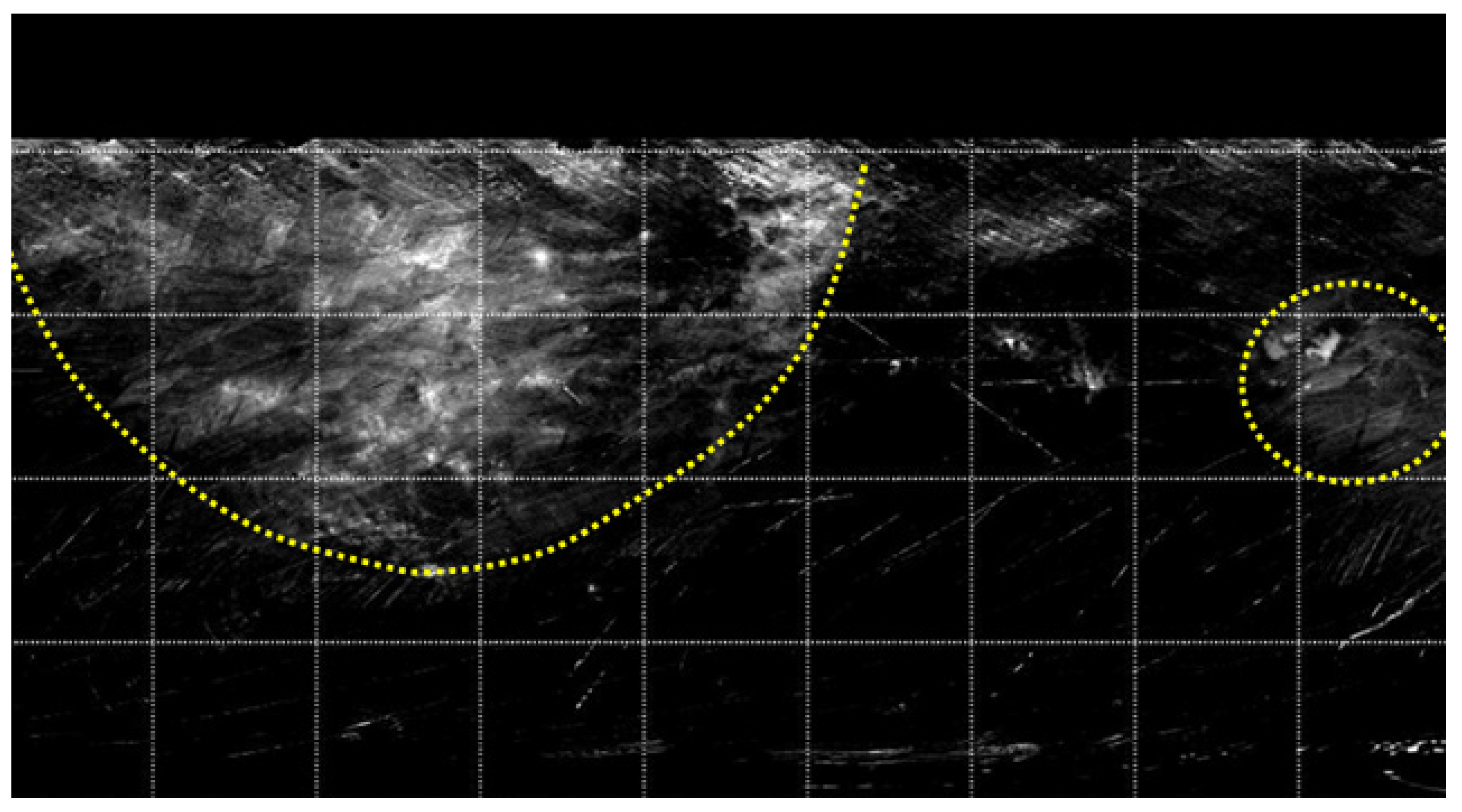
2.2.2. (24) Themis
2.2.3. (65) Cybele
2.2.4. Quasi-Hilda Comets
2.3. Potential Ice in the Jovian Trojans
2.4. Potential Ice in Near-Earth Asteroids
2.5. Dark Comets
3. Origin of Ice in the Inner Solar System Small Bodies
3.1. Dynamical Stability of Orbits of Active Asteroids
3.2. Role of Ice in Orbital Evolution
3.3. History of Geological and Chemical Changes
4. Next Steps for Icy Asteroid Survey
- How the optical identification of comae is possible and expected to occur, primarily through LSST/Vera Rubin observations,
- How spectral water-ice identification is expected by the JWST (which already demonstrated the related capability [40])
4.1. Potential for LSST/Vera Rubin Observations
4.2. Upcoming Facilities for Asteroid Research
4.3. Potential for Infrared Spectral Ice Identification
Author Contributions
Funding
Data Availability Statement
Conflicts of Interest
References
- Rousselot, P.; Opitom, C.; Jehin, E.; Hutsemékers, D.; Manfroid, J.; Villarreal, M.N.; Li, J.Y.; Castillo-Rogez, J.; Russell, C.T.; Vernazza, P.; et al. Search for water outgassing of (1) Ceres near perihelion. Astron. Astrophys. 2019, 628, A22. [Google Scholar] [CrossRef]
- Cheng, Y.C.; Bolin, B.T.; Kelley, M.S.P.; Bodewits, D.; Ye, Q.; Fremling, C.; Lin, Z.Y.; Wu, Y.L.; Riddle, R.L.; Ip, W.H.; et al. Postperihelion Cometary Activity on the Outer Main-belt Asteroid 2005 XR132. Planet. Sci. J. 2024, 5, 78. [Google Scholar] [CrossRef]
- Liu, B.; Li, C.; Mu, Z.; Liu, X. Physical properties of newly active asteroid 2010 LH15. Astron. Astrophys. 2025, 693, A168. [Google Scholar] [CrossRef]
- McCoy, T.J.; Russell, S.S.; Zega, T.J.; Thomas-Keprta, K.L.; Singerling, S.A.; Brenker, F.E.; Timms, N.E.; Rickard, W.D.A.; Barnes, J.J.; Libourel, G.; et al. An evaporite sequence from ancient brine recorded in Bennu samples. Nature 2025, 637, 1072–1077. [Google Scholar] [CrossRef]
- Ribeiro de Sousa, R.; Morbidelli, A.; Gomes, R.; Neto, E.V.; Izidoro, A.; Alves, A.A. Dynamical origin of the Dwarf Planet Ceres. Icarus 2022, 379, 114933. [Google Scholar] [CrossRef]
- Takir, D.; Neumann, W.; Raymond, S.N.; Emery, J.P.; Trieloff, M. Late accretion of Ceres-like asteroids and their implantation into the outer main belt. Nat. Astron. 2023, 7, 524–533. [Google Scholar] [CrossRef]
- Encrenaz, T. Water in the solar system. Annu. Rev. Astron. Astrophys. 2008, 46, 57–87. [Google Scholar] [CrossRef]
- Sridhar, S.; Bryson, J.F.J.; King, A.J.; Harrison, R.J. Constraints on the ice composition of carbonaceous chondrites from their magnetic mineralogy. Earth Planet. Sci. Lett. 2021, 576, 117243. [Google Scholar] [CrossRef]
- Jewitt, D. The Active Asteroids. Astron. J. 2012, 143, 66. [Google Scholar] [CrossRef]
- Levasseur-Regourd, A.C.; Agarwal, J.; Cottin, H.; Engrand, C.; Flynn, G.; Fulle, M.; Gombosi, T.; Langevin, Y.; Lasue, J.; Mannel, T.; et al. Cometary Dust. Space Sci. Rev. 2018, 214, 64. [Google Scholar] [CrossRef]
- Thomas, N.; Ulamec, S.; Kührt, E.; Ciarletti, V.; Gundlach, B.; Yoldi, Z.; Schwehm, G.; Snodgrass, C.; Green, S.F. Towards New Comet Missions. Space Sci. Rev. 2019, 215, 47. [Google Scholar] [CrossRef]
- Keller, H.U.; Kührt, E. Cometary Nuclei—From Giotto to Rosetta. Space Sci. Rev. 2020, 216, 14. [Google Scholar] [CrossRef]
- Rivkin, A.S.; Emery, J.P. Detection of ice and organics on an asteroidal surface. Nature 2010, 464, 1322–1323. [Google Scholar] [CrossRef]
- Campins, H.; Hargrove, K.; Pinilla-Alonso, N.; Howell, E.S.; Kelley, M.S.; Licandro, J.; Mothé-Diniz, T.; Fernández, Y.; Ziffer, J. Water ice and organics on the surface of the asteroid 24 Themis. Nature 2010, 464, 1320–1321. [Google Scholar] [CrossRef]
- Licandro, J.; Campins, H. Are the main belt comets, comets? Proc. Int. Astron. Union 2010, 263, 215–217. [Google Scholar] [CrossRef]
- Jewitt, D. From Comets to Asteroids: When Hairy Stars Go Bald. Earth Moon Planets 1996, 72, 185–201. [Google Scholar] [CrossRef]
- Hsieh, H.H.; Jewitt, D. Search for Active Main-Belt Asteroids: The SAMBA Project. In Proceedings of the AAS/Division for Planetary Sciences Meeting Abstracts #37, Cambridge, UK, 4–8 September 2005; Volume 37, p. 11.01. [Google Scholar]
- Hsieh, H.H.; Jewitt, D. Active asteroids: Mystery in the Main Belt. Proc. Int. Astron. Union 2006, 229, 425–437. [Google Scholar] [CrossRef]
- Jewitt, D. Icy Bodies in the New Solar System. Proc. Int. Astron. Union 2010, 263, 3–16. [Google Scholar] [CrossRef]
- Hsieh, H.H.; Jewitt, D.C.; Fernández, Y.R. The Strange Case of 133P/Elst-Pizarro: A Comet among the Asteroids. Astron. J. 2004, 127, 2997–3017. [Google Scholar] [CrossRef]
- Snodgrass, C.; Agarwal, J.; Combi, M.; Fitzsimmons, A.; Guilbert-Lepoutre, A.; Hsieh, H.H.; Hui, M.T.; Jehin, E.; Kelley, M.S.P.; Knight, M.M.; et al. The Main Belt Comets and ice in the Solar System. Astron. Astrophys. Rev. 2017, 25, 5. [Google Scholar] [CrossRef]
- Luu, J. Comets Disguised as Asteroids. Publ. Astron. Soc. Pac. 1994, 106, 425. [Google Scholar] [CrossRef]
- Weissman, P.R.; Bottke, W.F., Jr.; Levison, H.F. Evolution of Comets into Asteroids. In Asteroids III; University of Arizona Press: Tucson, AZ, USA, 2002; pp. 669–686. [Google Scholar]
- Rivkin, A.S.; Campins, H.; Emery, J.P.; Howell, E.S.; Licandro, J.; Takir, D.; Vilas, F. Astronomical Observations of Volatiles on Asteroids. In Asteroids IV; University of Arizona Press: Tucson, AZ, USA, 2015; pp. 65–87. [Google Scholar] [CrossRef]
- Jewitt, D.; Hsieh, H.; Agarwal, J. The Active Asteroids. In Asteroids IV; University of Arizona Press: Tucson, AZ, USA, 2015; pp. 221–241. [Google Scholar] [CrossRef]
- Filacchione, G.; Capaccioni, F.; Ciarniello, M.; Raponi, A.; Rinaldi, G.; De Sanctis, M.C.; Bockelèe-Morvan, D.; Erard, S.; Arnold, G.; Mennella, V.; et al. An orbital water-ice cycle on comet 67P from colour changes. Nature 2020, 578, 49–52. [Google Scholar] [CrossRef]
- Jewitt, D.; Li, J.; Agarwal, J.; Weaver, H.; Mutchler, M.; Larson, S. Nucleus and Mass Loss from Active Asteroid 313P/Gibbs. Astron. J. 2015, 150, 76. [Google Scholar] [CrossRef]
- De Sanctis, M.C.; Capaccioni, F.; Ciarniello, M.; Filacchione, G.; Formisano, M.; Mottola, S.; Raponi, A.; Tosi, F.; Bockelée-Morvan, D.; Erard, S.; et al. The diurnal cycle of water ice on comet 67P/Churyumov–Gerasimenko. Nature 2015, 525, 500–503. [Google Scholar] [CrossRef]
- Toth, I. Impact-generated activity period of the asteroid 7968 Elst-Pizarro in 1996: Identification of the asteroid 427 Galene as the most probable parent body of the impactors. Astron. Astrophys. 2000, 360, 375–380. [Google Scholar]
- Molaro, J.L.; Hergenrother, C.W.; Chesley, S.R.; Walsh, K.J.; Hanna, R.D.; Haberle, C.W.; Schwartz, S.R.; Ballouz, R.L.; Bottke, W.F.; Campins, H.J.; et al. Thermal Fatigue as a Driving Mechanism for Activity on Asteroid Bennu. J. Geophys. Res. (Planets) 2020, 125, e06325. [Google Scholar] [CrossRef]
- Lauretta, D.S.; Hergenrother, C.W.; Chesley, S.R.; Leonard, J.M.; Pelgrift, J.Y.; Adam, C.D.; Al Asad, M.; Antreasian, P.G.; Ballouz, R.L.; Becker, K.J.; et al. Episodes of particle ejection from the surface of the active asteroid (101955) Bennu. Science 2019, 366, eaay3544. [Google Scholar] [CrossRef]
- Steckloff, J.K.; Sarid, G.; Johnson, B.C. The Effects of Early Collisional Evolution on Amorphous Water Ice Bodies. Planet. Sci. J. 2023, 4, 4. [Google Scholar] [CrossRef]
- Golabek, G.; Jutzi, M. Modification of icy planetesimal interiors by early thermal evolution and collisions. In Proceedings of the European Planetary Science Congress, Granada, Spain, 18–23 September 2022; p. EPSC2022–1038. [Google Scholar] [CrossRef]
- Farkas-Takács, A.; Kiss, C.; Góbi, S.; Kereszturi, Á. Serpentinization in the Thermal Evolution of Icy Kuiper Belt Objects in the Early Solar System. Planet. Sci. J. 2022, 3, 54. [Google Scholar] [CrossRef]
- Gronoff, G.; Maggiolo, R.; Cessateur, G.; Moore, W.; Airapetian, V.; De Keyser, J.; Dhooghe, F.; Gibbons, A.; Gunell, H.; Mertens, C.J.; et al. The effects of cosmic rays on cometary nuclei. Astrophys. J. 2021, 237, 405.04. [Google Scholar]
- Jewitt, D.; Li, J. Activity in Geminid Parent (3200) Phaethon. Astron. J. 2010, 140, 1519–1527. [Google Scholar] [CrossRef]
- Davies, J.K.; Roush, T.L.; Cruikshank, D.P.; Bartholomew, M.J.; Geballe, T.R.; Owen, T.; de Bergh, C. The Detection of Water Ice in Comet Hale-Bopp. Icarus 1997, 127, 238–245. [Google Scholar] [CrossRef]
- Snodgrass, C.; Holt, C.E.; Kelley, M.S.P.; Opitom, C.; Guilbert-Lepoutre, A.; Knight, M.M.; Kokotanekova, R.; Jehin, E.; Mazzotta Epifani, E.; Migliorini, A.; et al. First JWST spectrum of distant activity in long-period comet C/2024 E1 (Wierzchos). Mon. Not. R. Astron. Soc. 2025, 541, L8–L13. [Google Scholar] [CrossRef]
- Barber, R.J.; Miller, S.; Dello Russo, N.; Mumma, M.J.; Tennyson, J.; Guio, P. Water in the near-infrared spectrum of comet 8P/Tuttle. Mon. Not. R. Astron. Soc. 2009, 398, 1593–1600. [Google Scholar] [CrossRef]
- Kelley, M.S.P.; Hsieh, H.H.; Bodewits, D.; Saki, M.; Villanueva, G.L.; Milam, S.N.; Hammel, H.B. Spectroscopic identification of water emission from a main-belt comet. Nature 2023, 619, 720–723. [Google Scholar] [CrossRef]
- Hsieh, H.H.; Noonan, J.W.; Kelley, M.S.P.; Bodewits, D.; Pittichová, J.; Thirouin, A.; Micheli, M.; Knight, M.M.; Bannister, M.T.; Chandler, C.O.; et al. The Volatile Composition and Activity Evolution of Main-belt Comet 358P/PANSTARRS. Planet. Sci. J. 2025, 6, 3. [Google Scholar] [CrossRef]
- Hsieh, H.H.; Denneau, L.; Wainscoat, R.J.; Schörghofer, N.; Bolin, B.; Fitzsimmons, A.; Jedicke, R.; Kleyna, J.; Micheli, M.; Vereš, P.; et al. The main-belt comets: The Pan-STARRS1 perspective. Icarus 2015, 248, 289–312. [Google Scholar] [CrossRef]
- Hsieh, H.H.; Haghighipour, N. Potential Jupiter-Family comet contamination of the main asteroid belt. Icarus 2016, 277, 19–38. [Google Scholar] [CrossRef]
- Zhang, Y.; Michel, P. Tidal distortion and disruption of rubble-pile bodies revisited. Soft-sphere discrete element analyses. Astron. Astrophys. 2020, 640, A102. [Google Scholar] [CrossRef]
- Jewitt, D.; Agarwal, J.; Li, J.; Weaver, H.; Mutchler, M.; Larson, S. Disintegrating Asteroid P/2013 R3. Astrophys. J. Lett. 2014, 784, L8. [Google Scholar] [CrossRef]
- Michel, P.; Benz, W.; Tanga, P.; Richardson, D.C. Collisions and Gravitational Reaccumulation: Forming Asteroid Families and Satellites. Science 2001, 294, 1696–1700. [Google Scholar] [CrossRef]
- Hsieh, H.H.; Ishiguro, M.; Kim, Y.; Knight, M.M.; Lin, Z.Y.; Micheli, M.; Moskovitz, N.A.; Sheppard, S.S.; Thirouin, A.; Trujillo, C.A. The 2016 Reactivations of the Main-belt Comets 238P/Read and 288P/(300163) 2006 VW139. Astron. J. 2018, 156, 223. [Google Scholar] [CrossRef]
- Shi, J.; Ma, Y.; Liang, H.; Xu, R. Research of activity of Main Belt Comets 176P/LINEAR, 238P/Read and 288P/(300163) 2006 VW139. Sci. Rep. 2019, 9, 5492. [Google Scholar] [CrossRef]
- Scully, J.E.C.; Yin, A.; Russell, C.T.; Buczkowski, D.L.; Williams, D.A.; Blewett, D.T.; Ruesch, O.; Hiesinger, H.; Le Corre, L.; Mercer, C.; et al. Geomorphology and structural geology of Saturnalia Fossae and adjacent structures in the northern hemisphere of Vesta. Icarus 2014, 244, 23–40. [Google Scholar] [CrossRef]
- Palmer, E.M.; Heggy, E.; Kofman, W. Orbital bistatic radar observations of asteroid Vesta by the Dawn mission. Nat. Commun. 2017, 8, 409. [Google Scholar] [CrossRef]
- Hargrove, K.D.; Emery, J.P.; Campins, H.; Kelley, M.S.P. Asteroid (90) Antiope: Another icy member of the Themis family? Icarus 2015, 254, 150–156. [Google Scholar] [CrossRef]
- Licandro, J.; Campins, H.; Kelley, M.; Hargrove, K.; Pinilla-Alonso, N.; Cruikshank, D.; Rivkin, A.S.; Emery, J. (65) Cybele: Detection of small silicate grains, water-ice, and organics. Astron. Astrophys. 2011, 525, A34. [Google Scholar] [CrossRef]
- Toth, I. The quasi-Hilda subgroup of ecliptic comets—An update. Astron. Astrophys. 2006, 448, 1191–1196. [Google Scholar] [CrossRef]
- Fernández, Y.R.; McFadden, L.A.; Lisse, C.M.; Helin, E.F.; Chamberlin, A.B. Analysis of POSS Images of Comet–Asteroid Transition Object 107P/1949 W1 (Wilson–Harrington). Icarus 1997, 128, 114–126. [Google Scholar] [CrossRef]
- Mommert, M.; Hora, J.L.; Harris, A.W.; Reach, W.T.; Emery, J.P.; Thomas, C.A.; Mueller, M.; Cruikshank, D.P.; Trilling, D.E.; Delbo, M.; et al. The Discovery of Cometary Activity in Near-Earth Asteroid (3552) Don Quixote. Astrophys. J. 2014, 781, 25. [Google Scholar] [CrossRef]
- Dominguez, G.; Gainsforth, Z.; Amano, K.; Kagawa, E.; Matsumoto, M.; Fujioka, Y.; Nakamura, T.; Morita, T.; Kikuiri, M.; Yurimoto, H.; et al. Nano-IR Imaging and Spectroscopy of a Ryugu Asteroid Sample. In Proceedings of the 53rd Lunar and Planetary Science Conference, The Woodlands, TX, USA, 7–11 March 2022; LPI Contributions. Volume 2678, p. 2736. [Google Scholar]
- Kaluna, H.; Meech, K. Analysis of the Activity on Main Belt Comet 133P/Elst-Pizarro. In Proceedings of the EPSC-DPS Joint Meeting 2011, Nantes, France, 2–7 October 2011; Volume 2011, p. 1375. [Google Scholar]
- Hsieh, H.H.; Forshay, P.; Schwamb, M. Comet 238P/Read. Cent. Bur. Electron. Telegrams 2016, 4307, 1. [Google Scholar]
- Hsieh, H.H.; Meech, K.J.; Pittichová, J. Main-belt Comet 238P/Read Revisited. Astrophys. J. Lett. 2011, 736, L18. [Google Scholar] [CrossRef][Green Version]
- Haghighipour, N. Dynamical constraints on the origin of Main Belt comets. Meteorit. Planet. Sci. 2009, 44, 1863–1869. [Google Scholar] [CrossRef]
- Agarwal, J.; Jewitt, D.; Weaver, H.; Mutchler, M.; Larson, S. Hubble and Keck Telescope Observations of Active Asteroid 288P/300163 (2006 VW139). Astron. J. 2016, 151, 12. [Google Scholar] [CrossRef]
- Agarwal, J.; Jewitt, D.; Mutchler, M.; Weaver, H.; Larson, S. A binary main-belt comet. Nature 2017, 549, 357–359. [Google Scholar] [CrossRef] [PubMed]
- Agarwal, J.; Kim, Y.; Jewitt, D.; Mutchler, M.; Weaver, H.; Larson, S. Component properties and mutual orbit of binary main-belt comet 288P/(300163) 2006 VW139. Astron. Astrophys. 2020, 643, A152. [Google Scholar] [CrossRef]
- Finson, M.; Probstein, R. A theory of dust comets. 1. Model and equations. Astrophys. J. 1968, 154, 327. [Google Scholar] [CrossRef]
- Hsieh, H.H.; Hainaut, O.; Novaković, B.; Bolin, B.; Denneau, L.; Fitzsimmons, A.; Haghighipour, N.; Kleyna, J.; Kokotanekova, R.; Lacerda, P.; et al. Sublimation-Driven Activity in Main-Belt Comet 313p/Gibbs. Astrophys. J. Lett. 2015, 800, L16. [Google Scholar] [CrossRef]
- Scully, J.E.C.; Russell, C.T.; Yin, A.; Jaumann, R.; Carey, E.; Castillo-Rogez, J.; McSween, H.Y.; Raymond, C.A.; Reddy, V.; Le Corre, L. Geomorphological evidence for transient water flow on Vesta. Earth Planet. Sci. Lett. 2015, 411, 151–163. [Google Scholar] [CrossRef]
- Kossacki, K.J.; Wesołowski, M.; Skóra, G.; Staszkiewicz, K. Comets, sliding of surface dust II. Icarus 2022, 379, 114946. [Google Scholar] [CrossRef]
- Reddy, V.; Le Corre, L.; O’Brien, D.P.; Nathues, A.; Cloutis, E.A.; Durda, D.D.; Bottke, W.F.; Bhatt, M.U.; Nesvorny, D.; Buczkowski, D.; et al. Delivery of dark material to Vesta via carbonaceous chondritic impacts. Icarus 2012, 221, 544–559. [Google Scholar] [CrossRef]
- Prettyman, T.H.; Mittlefehldt, D.W.; Yamashita, N.; Lawrence, D.J.; Beck, A.W.; Feldman, W.C.; McCoy, T.J.; McSween, H.Y.; Toplis, M.J.; Titus, T.N.; et al. Elemental Mapping by Dawn Reveals Exogenic H in Vesta’s Regolith. Science 2012, 338, 242. [Google Scholar] [CrossRef] [PubMed]
- De Sanctis, M.C.; Combe, J.P.; Ammannito, E.; Palomba, E.; Longobardo, A.; McCord, T.B.; Marchi, S.; Capaccioni, F.; Capria, M.T.; Mittlefehldt, D.W.; et al. Detection of Widespread Hydrated Materials on Vesta by the VIR Imaging Spectrometer on board the Dawn Mission. Astrophys. J. Lett. 2012, 758, L36. [Google Scholar] [CrossRef]
- McCord, T.B.; Li, J.Y.; Combe, J.P.; McSween, H.Y.; Jaumann, R.; Reddy, V.; Tosi, F.; Williams, D.A.; Blewett, D.T.; Turrini, D.; et al. Dark material on Vesta from the infall of carbonaceous volatile-rich material. Nature 2012, 491, 83–86. [Google Scholar] [CrossRef]
- Turrini, D.; Combe, J.P.; McCord, T.B.; Oklay, N.; Vincent, J.B.; Prettyman, T.H.; McSween, H.Y.; Consolmagno, G.J.; De Sanctis, M.C.; Le Corre, L.; et al. The contamination of the surface of Vesta by impacts and the delivery of the dark material. Icarus 2014, 240, 86–102. [Google Scholar] [CrossRef]
- Sarafian, A.R.; Roden, M.F.; PatiñO-Douce, A.E. The volatile content of Vesta: Clues from apatite in eucrites. Meteorit. Planet. Sci. 2013, 48, 2135–2154. [Google Scholar] [CrossRef]
- Sarafian, A.R.; Nielsen, S.G.; Marschall, H.R.; Gaetani, G.A.; Hauri, E.H.; Righter, K.; Sarafian, E. Volatile Addition to the Inner Solar System Between 4.566 and 4.564 Ga: Evidence from Angrite Meteorites. Microsc. Microanal. 2016, 22, 1802–1803. [Google Scholar] [CrossRef]
- Turrini, D.; Svetsov, V. The Formation of Jupiter, the Jovian Early Bombardment and the Delivery of Water to the Asteroid Belt: The Case of (4) Vesta. Life 2014, 4, 4–34. [Google Scholar] [CrossRef]
- Turrini, D.; Svetsov, V.; Consolmagno, G.; Sirono, S.; Jutzi, M. The late accretion and erosion of Vesta’s crust recorded by eucrites and diogenites as an astrochemical window into the formation of Jupiter and the early evolution of the Solar System. Icarus 2018, 311, 224–241. [Google Scholar] [CrossRef]
- McKay, A.J.; Bodewits, D.; Li, J.Y. Observational constraints on water sublimation from 24 Themis and 1 Ceres. Icarus 2017, 286, 308–313. [Google Scholar] [CrossRef]
- Schorghofer, N. The Lifetime of Ice on Main Belt Asteroids. Astrophys. J. 2008, 682, 697–705. [Google Scholar] [CrossRef]
- Castillo-Rogez, J.C.; Schmidt, B.E. Geophysical evolution of the Themis family parent body. Geophys. Res. Lett. 2010, 37. [Google Scholar] [CrossRef]
- Hsieh, H.H.; Novaković, B.; Kim, Y.; Brasser, R. Asteroid Family Associations of Active Asteroids. Astron. J. 2018, 155, 96. [Google Scholar] [CrossRef]
- Hsieh, H.H.; Novaković, B.; Walsh, K.J.; Schörghofer, N. Potential Themis-family Asteroid Contribution to the Jupiter-family Comet Population. Astron. J. 2020, 159, 179. [Google Scholar] [CrossRef]
- Jewitt, D.; Guilbert-Lepoutre, A. Limits to Ice on Asteroids (24) Themis and (65) Cybele. Astron. J. 2012, 143, 21. [Google Scholar] [CrossRef]
- Schubart, J. Long-Period Effects in the Motion of Hilda-Type Planets. Astron. J. 1968, 73, 99–103. [Google Scholar] [CrossRef]
- Schubart, J. Three Characteristic Parameters of Orbits of Hilda-type Asteroids. Astron. Astrophys. 1982, 114, 200–204. [Google Scholar]
- Brož, M.; Vokrouhlický, D. Asteroid families in the first-order resonances with Jupiter. Mon. Not. R. Astron. Soc. 2008, 390, 715–732. [Google Scholar] [CrossRef]
- Di Sisto, R.P.; Brunini, A.; Dirani, L.D.; Orellana, R.B. Hilda asteroids among Jupiter family comets. Icarus 2005, 174, 81–89. [Google Scholar] [CrossRef]
- Grav, T.; Mainzer, A.K.; Masiero, J.; Bauer, J.M.; Cutri, R.M.; McMillan, R.S.; Walker, R.G.; Wright, E.L. WISE Observations of Jupiter Trojans. In Proceedings of the 42nd Annual Lunar and Planetary Science Conference, The Woodlands, TX, USA, 7–11 March 2011; p. 2190. [Google Scholar]
- Ohtsuka, K.; Ito, T.; Yoshikawa, M.; Asher, D.J.; Arakida, H. Quasi-Hilda comet 147P/Kushida-Muramatsu. Another long temporary satellite capture by Jupiter. Astron. Astrophys. 2008, 489, 1355–1362. [Google Scholar] [CrossRef]
- Spratt, C.E. The Hilda group of minor planets. J. R. Astron. Soc. Can. 1989, 83, 393–404. [Google Scholar]
- Yang, B.; Sarid, G. Crystalline Water Ice In Outburst Comet P/2010 H2. In Proceedings of the AAS/Division for Planetary Sciences Meeting Abstracts #42, Pasadena, CA, USA, 4–8 October 2010; Volume 42, p. 5.09. [Google Scholar]
- Vales, J.; Kowalski, R.A.; Ryan, W.; Guido, E.; Sostero, G.; Miles, R.; Maury, A.; Kadota, K. Comet P/2010 H2. Cent. Bur. Electron. Telegrams 2010, 2249, 1. [Google Scholar]
- Gil-Hutton, R.; García-Migani, E. Comet candidates among quasi-Hilda objects. Astron. Astrophys. 2016, 590, A111. [Google Scholar] [CrossRef]
- Jewitt, D.; Kim, Y. Outbursting Quasi-Hilda Asteroid P/2010 H2 (Vales). Planet. Sci. J. 2020, 1, 77. [Google Scholar] [CrossRef]
- Chang, C.K.; Chen, Y.T.; Fraser, W.C.; Lehner, M.J.; Wang, S.Y.; Alexandersen, M.; Choi, Y.J.; Granados Contreras, A.P.; Ito, T.; JeongAhn, Y.; et al. FOSSIL. II. The Rotation Periods of Small-sized Hilda Asteroids. Astrophys. J. Suppl. Ser. 2022, 259, 7. [Google Scholar] [CrossRef]
- Musiichuk, E.Y.; Borysenko, S.A. Some peculiarities of activity for comets with orbits on 2–5 AU. Adv. Astron. Space Phys. 2019, 9, 3–7. [Google Scholar] [CrossRef]
- Borysenko, S.; Baransky, A.; Kuehrt, E.; Hellmich, S.; Mottola, S.; Meech, K. Study of the physical properties of selected active objects in the main belt and surrounding regions by broadband photometry. Astron. Nachrichten 2020, 341, 849–859. [Google Scholar] [CrossRef]
- Emery, J.P.; Binzel, R.P.; Britt, D.T.; Brown, M.E.; Howett, C.J.A.; Martin, A.C.; Melita, M.D.; Souza-Feliciano, A.C.; Wong, I. Surface Compositions of Trojan Asteroids. Space Sci. Rev. 2024, 220, 28. [Google Scholar] [CrossRef]
- Marchis, F.; Hestroffer, D.; Descamps, P.; Berthier, J.; Bouchez, A.H.; Campbell, R.D.; Chin, J.C.Y.; van Dam, M.A.; Hartman, S.K.; Johnasson, E.M.; et al. Multiplicity in the Jupiter Trojan Population: Low density of 617 Patroclus with Keck LGS AO and Perspective. In Proceedings of the American Astronomical Society Meeting Abstracts, Santa Barbara, CA, USA, 10–14 April 2005; Volume 207, p. 98.07. [Google Scholar]
- Marchis, F.; Hestroffer, D.; Descamps, P.; Berthier, J.; Bouchez, A.H.; Campbell, R.D.; Chin, J.C.Y.; van Dam, M.A.; Hartman, S.K.; Johansson, E.M.; et al. A low density of 0.8 g cm−3 for the Trojan binary asteroid 617 Patroclus. Nature 2006, 439, 565–567. [Google Scholar] [CrossRef] [PubMed]
- Grundy, W.M.; Stansberry, J.A.; Noll, K.S.; Stephens, D.C.; Trilling, D.E.; Kern, S.D.; Spencer, J.R.; Cruikshank, D.P.; Levison, H.F. The orbit, mass, size, albedo, and density of (65489) Ceto/Phorcys: A tidally-evolved binary Centaur. Icarus 2007, 191, 286–297. [Google Scholar] [CrossRef]
- Brown, M.E.; Levison, H.F.; Noll, K.S.; Binzel, R.; Buie, M.W.; Grundy, W.; Marchi, S.; Olkin, C.B.; Spencer, J.; Statler, T.S.; et al. The Orbit and Density of the Jupiter Trojan Satellite System Eurybates-Queta. Planet. Sci. J. 2021, 2, 170. [Google Scholar] [CrossRef]
- Jones, T.D.; Lebofsky, L.A.; Lewis, J.S.; Marley, M.S. The composition and origin of the C, P, and D asteroids: Water as a tracer of thermal evolution in the outer belt. Icarus 1990, 88, 172–192. [Google Scholar] [CrossRef]
- Dumas, C.; Owen, T.; Barucci, M.A. Near-Infrared Spectroscopy of Low-Albedo Surfaces of the Solar System: Search for the Spectral Signature of Dark Material. Icarus 1998, 133, 221–232. [Google Scholar] [CrossRef]
- Jewitt, D.C. From cradle to grave: The rise and demise of the comets. In Comets II; Festou, M.C., Keller, H.U., Weaver, H.A., Eds.; University of Arizona Press: Tucson, AZ, USA, 2004; p. 659. [Google Scholar]
- Marzari, F.; Scholl, H.; Murray, C.; Lagerkvist, C. Origin and Evolution of Trojan Asteroids. In Asteroids III; Bottke, W.F., Jr., Cellino, A., Paolicchi, P., Binzel, R.P., Eds.; University of Arizona Press: Tucson, AZ, USA, 2002; pp. 725–738. [Google Scholar]
- de Elía, G.C.; Brunini, A. Collisional and dynamical evolution of the L4 Trojan asteroids. Astron. Astrophys. 2007, 475, 375–389. [Google Scholar] [CrossRef]
- Guilbert-Lepoutre, A. Survival of water ice in Jupiter Trojans. Icarus 2014, 231, 232–238. [Google Scholar] [CrossRef]
- Yang, B.; Jewitt, D. Near Infrared Spectroscopy of Jovian Trojan Asteroids: A Search for Silicate Features. In Proceedings of the AAS/Division for Planetary Sciences Meeting Abstracts #39, Orlando, FL, USA, 7–12 October 2007; Volume 39, p. 33.12. [Google Scholar]
- Emery, J.P.; Marzari, F.; Morbidelli, A.; French, L.M.; Grav, T. The Complex History of Trojan Asteroids. In Asteroids IV; University of Arizona Press: Tucson, AZ, USA, 2015; pp. 203–220. [Google Scholar] [CrossRef]
- Wong, I.; Brown, M.E.; Emery, J.P.; Binzel, R.P.; Grundy, W.M.; Marchi, S.; Martin, A.C.; Noll, K.S.; Sunshine, J.M. JWST Near-infrared Spectroscopy of the Lucy Jupiter Trojan Flyby Targets: Evidence for OH Absorption, Aliphatic Organics, and CO2. Planet. Sci. J. 2024, 5, 87. [Google Scholar] [CrossRef]
- Markwardt, L.; Holler, B.J.; Lin, H.W.; Gerdes, D.W.; Adams, F.C.; Malhotra, R.; Napier, K.J. First Near-IR Spectroscopic Survey of Neptune Trojans with JWST: Distinct Surface Compositions of Red vs Ultra-Red Neptune Trojans. Planet. Sci. J. 2025; in press. [Google Scholar] [CrossRef]
- Jewitt, D. The Active Centaurs. Astron. J. 2009, 137, 4296–4312. [Google Scholar] [CrossRef]
- Cabral, N.; Guilbert-Lepoutre, A.; Fraser, W.C.; Marsset, M.; Volk, K.; Petit, J.M.; Rousselot, P.; Alexandersen, M.; Bannister, M.T.; Chen, Y.T.; et al. OSSOS. XI. No active centaurs in the Outer Solar System Origins Survey. Astron. Astrophys. 2019, 621, A102. [Google Scholar] [CrossRef]
- Gladman, B.; Marsden, B.G.; Vanlaerhoven, C. Nomenclature in the Outer Solar System. In The Solar System Beyond Neptune; Barucci, M.A., Boehnhardt, H., Cruikshank, D.P., Morbidelli, A., Dotson, R., Eds.; University of Arizona Press: Tucson, AZ, USA, 2008; pp. 43–57. [Google Scholar]
- Luu, J.X.; Jewitt, D.C. Kuiper Belt Objects: Relics from the Accretion Disk of the Sun. Annu. Rev. Astron. Astrophys. 2002, 40, 63–101. [Google Scholar] [CrossRef]
- Helin, E.F. 1979 VA. IAU Circ. 1979, 3422, 1. [Google Scholar]
- Bowell, E.; West, R.M.; Heyer, H.H.; Quebatte, J.; Cunningham, L.E.; Bus, S.J.; Harris, A.W.; Millis, R.L.; Marsden, B.G. (4015) 1979 VA = Comet Wilson-Harrington (1949 III). IAU Circ. 1992, 5585, 1. [Google Scholar]
- Mommert, M.; Trilling, D.; Knight, M.M.; Hora, J.; Biver, N.; Womack, M.; Wierzchos, K.; Polishook, D.; Veres, P.; Gustafsson, A.; et al. Systematic Characterization and Monitoring of Potentially Active Asteroids: The Case of Don Quixote. In Proceedings of the AAS/Division for Planetary Sciences Meeting Abstracts #50, Knoxville, TN, USA, 21–26 October 2018; Volume 50, p. 505.05. [Google Scholar]
- Marshall, S.E.; Taylor, P.A.; Rivera-Valentin, E.G.; Venditti, F.C.F.; Virkki, A.K.; Benner, L.A.M.; Brozovic, M.; Naidu, S.P.; Zambrano-Marin, L.F.; Bhiravarasu, S.S.; et al. Shape model of 3200 Phaethon from radar, lightcurve, and occultation observations. In Proceedings of the 7th IAA Planetary Defense Conference, Vienna, Austria, 26–30 April 2021; p. 231. [Google Scholar]
- Delbo, M.; Libourel, G.; Wilkerson, J.; Murdoch, N.; Michel, P.; Ramesh, K.T.; Ganino, C.; Verati, C.; Marchi, S. Thermal fatigue as the origin of regolith on small asteroids. Nature 2014, 508, 233–236. [Google Scholar] [CrossRef]
- Rozitis, B.; Emery, J.P.; Siegler, M.A.; Susorney, H.C.M.; Molaro, J.L.; Hergenrother, C.W.; Lauretta, D.S. Implications for Ice Stability and Particle Ejection From High-Resolution Temperature Modeling of Asteroid (101955) Bennu. J. Geophys. Res. (Planets) 2020, 125, e06323. [Google Scholar] [CrossRef]
- Seligman, D.Z.; Farnocchia, D.; Micheli, M.; Hainaut, O.R.; Hsieh, H.H.; Feinstein, A.D.; Chesley, S.R.; Taylor, A.G.; Masiero, J.; Meech, K.J. Two distinct populations of dark comets delineated by orbits and sizes. Proc. Natl. Acad. Sci. USA 2024, 121, e2406424121. [Google Scholar] [CrossRef]
- Seligman, D.Z.; Farnocchia, D.; Micheli, M.; Vokrouhlický, D.; Taylor, A.G.; Chesley, S.R.; Bergner, J.B.; Vereš, P.; Hainaut, O.R.; Meech, K.J.; et al. Dark Comets? Unexpectedly Large Nongravitational Accelerations on a Sample of Small Asteroids. Planet. Sci. J. 2023, 4, 35. [Google Scholar] [CrossRef]
- Butler, B.J.; Muhleman, D.O.; Slade, M.A. Mercury: Full-disk radar images and the detection and stability of ice at the North Pole. J. Geophys. Res. Planets 1993, 98, 15003–15023. [Google Scholar] [CrossRef]
- Vasavada, A.R.; Paige, D.A.; Wood, S.E. Near-Surface Temperatures on Mercury and the Moon and the Stability of Polar Ice Deposits. Icarus 1999, 141, 179–193. [Google Scholar] [CrossRef]
- Campbell, B.; Campbell, D. Regolith properties in the south polar region of the Moon from 70-cm radar polarimetry. Icarus 2006, 180, 1–7. [Google Scholar] [CrossRef]
- Alexander, C.M.O.; McKeegan, K.D.; Altwegg, K. Water Reservoirs in Small Planetary Bodies: Meteorites, Asteroids, and Comets. Space Sci. Rev. 2018, 214, 36. [Google Scholar] [CrossRef] [PubMed]
- Schörghofer, N.; Hsieh, H.H.; Novaković, B.; Walsh, K.J. Preservation of polar ice on near-Earth asteroids originating in the outer main belt: A model study with dynamical trajectories. Icarus 2020, 348, 113865. [Google Scholar] [CrossRef]
- Szabó, G.M.; Pál, A.; Szigeti, L.; Bognár, Z.; Bódi, A.; Kalup, C.; Jäger, Z.J.; Kiss, L.L.; Kiss, C.; Kovács, J.; et al. Rotation periods and shape asphericity in asteroid families based on TESS S1-S13 observations. Astron. Astrophys. 2022, 661, A48. [Google Scholar] [CrossRef]
- A’Hearn, M.F.; Feldman, P.D. Water vaporization on Ceres. Icarus 1992, 98, 54–60. [Google Scholar] [CrossRef]
- Fulle, M.; Della Corte, V.; Rotundi, A.; Green, S.F.; Accolla, M.; Colangeli, L.; Ferrari, M.; Ivanovski, S.; Sordini, R.; Zakharov, V. The dust-to-ices ratio in comets and Kuiper belt objects. Mon. Not. R. Astron. Soc. 2017, 469, S45–S49. [Google Scholar] [CrossRef]
- Hsieh, H.; Walsh, K.; Novaković, B.; Schörghofer, N. The Themis asteroid family: A potential comet nursery. In Proceedings of the EPSC-DPS Joint Meeting 2019, Geneva, Switzerland, 15–20 September 2019; Volume 2019, p. EPSC–DPS2019–815. [Google Scholar]
- Tsiganis, K.; Gomes, R.; Morbidelli, A.; Levison, H.F. Origin of the orbital architecture of the giant planets of the Solar System. Nature 2005, 435, 459–461. [Google Scholar] [CrossRef] [PubMed]
- Gomes, R.S.; Gallardo, T.; Fernández, J.A.; Brunini, A. On The Origin of The High-Perihelion Scattered Disk: The Role of The Kozai Mechanism And Mean Motion Resonances. Celest. Mech. Dyn. Astron. 2005, 91, 109–129. [Google Scholar] [CrossRef]
- Levison, H.F.; Bottke, W.F.; Gounelle, M.; Morbidelli, A.; Nesvorný, D.; Tsiganis, K. Contamination of the asteroid belt by primordial trans-Neptunian objects. Nature 2009, 460, 364–366. [Google Scholar] [CrossRef] [PubMed]
- Walsh, K.J.; Morbidelli, A.; Raymond, S.N.; O’Brien, D.P.; Mandell, A.M. A low mass for Mars from Jupiter’s early gas-driven migration. Nature 2011, 475, 206–209. [Google Scholar] [CrossRef]
- Harrison, T.M. Hadean Earth; Springer: Charm, Switzerland, 2020. [Google Scholar] [CrossRef]
- Cartwright, J.A.; Hodges, K.V.; Wadhwa, M. Evidence against a Late Heavy Bombardment event on Vesta. Earth Planet. Sci. Lett. 2022, 590, 117576. [Google Scholar] [CrossRef]
- Turrini, D.; Magni, G.; Coradini, A. Probing the history of Solar system through the cratering records on Vesta and Ceres. Mon. Not. R. Astron. Soc. 2011, 413, 2439–2466. [Google Scholar] [CrossRef]
- Raymond, S.N.; Izidoro, A. Origin of water in the inner Solar System: Planetesimals scattered inward during Jupiter and Saturn’s rapid gas accretion. Icarus 2017, 297, 134–148. [Google Scholar] [CrossRef]
- Pirani, S.; Johansen, A.; Bitsch, B.; Mustill, A.J.; Turrini, D. Consequences of planetary migration on the minor bodies of the early solar system. Astron. Astrophys. 2019, 623, A169. [Google Scholar] [CrossRef]
- Öberg, K.I.; Wordsworth, R. Jupiter’s Composition Suggests its Core Assembled Exterior to the N2 Snowline. Astron. J. 2019, 158, 194. [Google Scholar] [CrossRef]
- D’Angelo, G.; Marzari, F. Outward Migration of Jupiter and Saturn in Evolved Gaseous Disks. Astrophys. J. 2012, 757, 50. [Google Scholar] [CrossRef]
- Wetherill, G.W. An alternative model for the formation of the asteroids. Icarus 1992, 100, 307–325. [Google Scholar] [CrossRef]
- Petit, J.M.; Morbidelli, A.; Chambers, J. The Primordial Excitation and Clearing of the Asteroid Belt. Icarus 2001, 153, 338–347. [Google Scholar] [CrossRef]
- O’Brien, D.P.; Morbidelli, A.; Bottke, W.F. The primordial excitation and clearing of the asteroid belt—Revisited. Icarus 2007, 191, 434–452. [Google Scholar] [CrossRef]
- Morbidelli, A.; Chambers, J.; Lunine, J.I.; Petit, J.M.; Robert, F.; Valsecchi, G.B.; Cyr, K.E. Source regions and time scales for the delivery of water to Earth. Meteorit. Planet. Sci. 2000, 35, 1309–1320. [Google Scholar] [CrossRef]
- Raymond, S.N.; Quinn, T.; Lunine, J.I. Making other earths: Dynamical simulations of terrestrial planet formation and water delivery. Icarus 2004, 168, 1–17. [Google Scholar] [CrossRef]
- Nagasawa, M.; Tanaka, H.; Ida, S. Orbital Evolution of Asteroids during Depletion of the Solar Nebula. Astron. J. 2000, 119, 1480–1497. [Google Scholar] [CrossRef]
- Minton, D.A.; Malhotra, R. A record of planet migration in the main asteroid belt. Nature 2009, 457, 1109–1111. [Google Scholar] [CrossRef] [PubMed]
- Bottke, W.F.; Vokrouhlický, D.; Minton, D.; Nesvorný, D.; Morbidelli, A.; Brasser, R.; Simonson, B.; Levison, H.F. An Archaean heavy bombardment from a destabilized extension of the asteroid belt. Nature 2012, 485, 78–81. [Google Scholar] [CrossRef]
- Chambers, J.E. On the stability of a planet between Mars and the asteroid belt: Implications for the Planet V hypothesis. Icarus 2007, 189, 386–400. [Google Scholar] [CrossRef]
- Hansen, B.M.S. Formation of the Terrestrial Planets from a Narrow Annulus. Astrophys. J. 2009, 703, 1131–1140. [Google Scholar] [CrossRef]
- Polychroni, D.; Turrini, D.; Ivanovski, S.; Marzari, F.; Testi, L.; Politi, R.; Sozzetti, A.; Trigo-Rodriguez, J.M.; Desidera, S.; Drozdovskaya, M.N.; et al. HD 163296 and its giant planets: Creation of exo-comets, interstellar objects and transport of volatile material. Astron. Astrophys. 2025, 697, A158. [Google Scholar] [CrossRef]
- Morbidelli, A.; Levison, H.F.; Tsiganis, K.; Gomes, R. Chaotic capture of Jupiter’s Trojan asteroids in the early Solar System. Nature 2005, 435, 462–465. [Google Scholar] [CrossRef] [PubMed]
- de la Fuente Marcos, C.; de la Fuente Marcos, R. Recent arrivals to the main asteroid belt. Celest. Mech. Dyn. Astron. 2022, 134, 38. [Google Scholar] [CrossRef]
- Morbidelli, A.; Bottke, W.F., Jr.; Froeschlé, C.; Michel, P. Origin and Evolution of Near-Earth Objects. In Asteroids III; Bottke, W.F., Jr., Cellino, A., Paolicchi, P., Binzel, R.P., Eds.; University of Arizona Press: Tucson, AZ, USA, 2002; pp. 409–422. [Google Scholar]
- Zhang, Q.; Battams, K.; Ye, Q.; Knight, M.M.; Schmidt, C.A. Sodium Brightening of (3200) Phaethon near Perihelion. Planet. Sci. J. 2023, 4, 70. [Google Scholar] [CrossRef]
- Hui, M.T.; Jewitt, D. Non-gravitational Acceleration of the Active Asteroids. Astron. J. 2017, 153, 80. [Google Scholar] [CrossRef]
- Hsieh, H.H. The nucleus of main-belt Comet P/2010 R2 (La Sagra). Icarus 2014, 243, 16–26. [Google Scholar] [CrossRef]
- Hasegawa, S.; Marsset, M.; DeMeo, F.E.; Bus, S.J.; Geem, J.; Ishiguro, M.; Im, M.; Kuroda, D.; Vernazza, P. Discovery of Two TNO-like Bodies in the Asteroid Belt. Astrophys. J. Lett. 2021, 916, L6. [Google Scholar] [CrossRef]
- Marzari, F.; Farinella, P.; Vanzani, V. Are Trojan collisional families a source for short-period comets? Astron. Astrophys. 1995, 299, 267. [Google Scholar]
- Horner, J.; Lykawka, P.S. The Neptune Trojans–A new source for the Centaurs? Mon. Not. R. Astron. Soc. 2010, 402, 13–20. [Google Scholar] [CrossRef]
- Horner, J.; Lykawka, P.S. Planetary Trojans—The main source of short period comets? Int. J. Astrobiol. 2010, 9, 227–234. [Google Scholar] [CrossRef]
- McKinnon, W.B. On the Possibility of Large KBOs Being Injected into the Outer Asteroid Belt. In Proceedings of the AAS/Division for Planetary Sciences Meeting Abstracts #40, Ithaca, NY, USA, 10–15 October 2008; Volume 40, p. 38.03. [Google Scholar]
- Marrocchi, Y.; Bekaert, D.V.; Piani, L. Origin and abundance of water in carbonaceous asteroids. Earth Planet. Sci. Lett. 2018, 482, 23–32. [Google Scholar] [CrossRef]
- Zolensky, M.; McSween, H.Y., Jr. Aqueous alteration. In Meteorites and the Early Solar System; Kerridge, J.F., Matthews, M.S., Eds.; University of Arizona Press: Tucson, AZ, USA, 1988; pp. 114–143. [Google Scholar]
- Saylor, J.; Zolensky, M.E.; Bodnar, R.J.; Le, L.; Schwandt, C. Fluid Inclusions in Carbonaceous Chondrites. In Proceedings of the Lunar and Planetary Science Conference, Houston, TX, USA, 12–16 March 2001; p. 1875. [Google Scholar]
- Yurimoto, H.; Itoh, S.; Zolensky, M.; Kusakabe, M.; Karen, A.; Bodnar, R. Isotopic compositions of asteroidal liquid water trapped in fluid inclusions of chondrites. Geochem. J. 2014, 48, 549–560. [Google Scholar] [CrossRef]
- Zolensky, M.E.; Bodnar, R.J.; Gibson, E.K., Jr.; Nyquist, L.E.; Reese, Y.; Shih, C.Y.; Wiesmann, H. Asteroidal water within fluid inclusion-bearing halite in an H5 chondrite, Monahans (1998). Science 1999, 285, 1377–1379. [Google Scholar] [CrossRef] [PubMed]
- Chan, Q.H.S.; Zolensky, M.E.; Kebukawa, Y.; Fries, M.; Ito, M.; Steele, A.; Rahman, Z.; Nakato, A.; Kilcoyne, A.L.D.; Suga, H.; et al. Organic matter in extraterrestrial water-bearing salt crystals. Sci. Adv. 2018, 4, eaao3521. [Google Scholar] [CrossRef] [PubMed]
- Matsumoto, M.; Tsuchiyama, A.; Nakato, A.; Matsuno, J.; Miyake, A.; Kataoka, A.; Ito, M.; Tomioka, N.; Kodama, Y.; Uesugi, K.; et al. Discovery of fossil asteroidal ice in primitive meteorite Acfer 094. Sci. Adv. 2019, 5, eaax5078. [Google Scholar] [CrossRef]
- DeMeo, F.E.; Burt, B.J.; Marsset, M.; Polishook, D.; Burbine, T.H.; Carry, B.; Binzel, R.P.; Vernazza, P.; Reddy, V.; Tang, M.; et al. Connecting Asteroids and Meteorites with visible and near-infrared spectroscopy. Icarus 2022, 380, 114971. [Google Scholar] [CrossRef]
- Krämer Ruggiu, L.; Beck, P.; Gattacceca, J.; Eschrig, J. Visible-infrared spectroscopy of ungrouped and rare meteorites brings further constraints on meteorite-asteroid connections. Icarus 2021, 362, 114393. [Google Scholar] [CrossRef]
- Lamy, P.L.; Toth, I.; Fernandez, Y.R.; Weaver, H.A. The sizes, shapes, albedos, and colors of cometary nuclei. In Comets II; Festou, M.C., Keller, H.U., Weaver, H.A., Eds.; University of Arizona Press: Tucson, AZ, USA, 2004; p. 223. [Google Scholar]
- Spitale, J.N.; Greenberg, R. The Yarkovsky effect: Role of asteroid shape and albedo distribution. In Proceedings of the AAS/Division for Planetary Sciences Meeting Abstracts #33, New Orleans, LA, USA, 27 November–1 December 2001; Volume 33, p. 54.03. [Google Scholar]
- Vokrouhlický, D. Yarkovsky effect on a body with variable albedo. Astron. Astrophys. 2006, 459, 275–282. [Google Scholar] [CrossRef]
- Pätzold, M.; Andert, T.P.; Hahn, M.; Barriot, J.P.; Asmar, S.W.; Häusler, B.; Bird, M.K.; Tellmann, S.; Oschlisniok, J.; Peter, K. The Nucleus of comet 67P/Churyumov-Gerasimenko—Part I: The global view—Nucleus mass, mass-loss, porosity, and implications. Mon. Not. R. Astron. Soc. 2019, 483, 2337–2346. [Google Scholar] [CrossRef]
- Marboeuf, U.; Schmitt, B.; Petit, J.M.; Mousis, O.; Fray, N. A cometary nucleus model taking into account all phase changes of water ice: Amorphous, crystalline, and clathrate. Astron. Astrophys. 2012, 542, A82. [Google Scholar] [CrossRef]
- Baragiola, R.A.; Famá, M.; Loeffler, M.J.; Raut, U.; Shi, J. Radiation effects in ice: New results. Nucl. Instrum. Methods Phys. Res. 2008, 266, 3057–3062. [Google Scholar] [CrossRef]
- Kossacki, K.J.; Szutowicz, S. Crystallization of ice in Comet 17P/Holmes: Probably not responsible for the explosive 2007 megaburst. Icarus 2010, 207, 320–340. [Google Scholar] [CrossRef]
- Kossacki, K.J.; Spohn, T.; Hagermann, A.; Kaufmann, E.; Kührt, E. Comet 67P/Churyumov-Gerasimenko: Hardening of the sub-surface layer. Icarus 2015, 260, 464–474. [Google Scholar] [CrossRef]
- Prialnik, D. Long-term evolution of small icy bodies of the Solar System. Proc. Int. Astron. Union 2010, 263, 121–125. [Google Scholar] [CrossRef]
- Vincent, J.B. Cometary topography and phase darkening. Astron. Astrophys. 2019, 624, A5. [Google Scholar] [CrossRef]
- El-Maarry, M.R.; Groussin, O.; Thomas, N.; Pajola, M.; Auger, A.T.; Davidsson, B.; Hu, X.; Hviid, S.F.; Knollenberg, J.; Güttler, C.; et al. Surface changes on comet 67P/Churyumov-Gerasimenko suggest a more active past. Science 2017, 355, 1392–1395. [Google Scholar] [CrossRef] [PubMed]
- Hirabayashi, M.; Scheeres, D.J.; Chesley, S.R.; Marchi, S.; McMahon, J.W.; Steckloff, J.; Mottola, S.; Naidu, S.P.; Bowling, T. Fission and reconfiguration of bilobate comets as revealed by 67P/Churyumov-Gerasimenko. Nature 2016, 534, 352–355. [Google Scholar] [CrossRef]
- Groussin, O.; Sierks, H.; Barbieri, C.; Lamy, P.; Rodrigo, R.; Koschny, D.; Rickman, H.; Keller, H.U.; A’Hearn, M.F.; Auger, A.T.; et al. Temporal morphological changes in the Imhotep region of comet 67P/Churyumov-Gerasimenko. Astron. Astrophys. 2015, 583, A36. [Google Scholar] [CrossRef]
- Pajola, M.; Höfner, S.; Vincent, J.B.; Oklay, N.; Scholten, F.; Preusker, F.; Mottola, S.; Naletto, G.; Fornasier, S.; Lowry, S.; et al. The pristine interior of comet 67P revealed by the combined Aswan outburst and cliff collapse. Nat. Astron. 2017, 1, 0092. [Google Scholar] [CrossRef]
- Hu, X.; Shi, X.; Sierks, H.; Fulle, M.; Blum, J.; Keller, H.U.; Kührt, E.; Davidsson, B.; Güttler, C.; Gundlach, B.; et al. Seasonal erosion and restoration of the dust cover on comet 67P/Churyumov-Gerasimenko as observed by OSIRIS onboard Rosetta. Astron. Astrophys. 2017, 604, A114. [Google Scholar] [CrossRef]
- Burgett, W.; Kaiser, N. The Pan-STARRS Project: The Next Generation of Survey Astronomy Has Arrived. In Proceedings of the Advanced Maui Optical and Space Surveillance Technologies Conference, Maui, HI, USA, 1–4 September 2009; p. E39. [Google Scholar]
- Schutt, T.; Jarvis, M.; Roodman, A.; Amon, A.; Becker, M.R.; Gruendl, R.A.; Yamamoto, M.; Bechtol, K.; Bernstein, G.M.; Gatti, M.; et al. Dark Energy Survey Year 6 Results: Point-Spread Function Modeling. Open J. Astrophys. 2025, 8, 26. [Google Scholar] [CrossRef]
- Rich, R.M.; Johnson, C.I.; Young, M.; Simion, I.T.; Clarkson, W.I.; Pilachowski, C.; Michael, S.; Kunder, A.; Katherina Vivas, A.; Koch, A.; et al. The Blanco DECam bulge survey. I. The survey description and early results. Mon. Not. R. Astron. Soc. 2020, 499, 2340–2356. [Google Scholar] [CrossRef]
- Masiero, J.R.; Linder, T.; Mainzer, A.; Dahlen, D.W.; Kwon, Y.G. Visual-band Brightnesses of Near-Earth Objects that will be Discovered in the Infrared by NEO Surveyor. Planet. Sci. J. 2024, 5, 222. [Google Scholar] [CrossRef]
- Slater, C.; Jurić, M.; Ivezić, Ž.; Jones, L. False Positive Rates in the LSST Image Differencing Pipeline. In LSST Data Management Technical Note (DMTN-006); Zenodo: Geneva, Switzerland, 2016. [Google Scholar] [CrossRef]
- Schörghofer, N.; Hsieh, H.H. Ice Loss From the Interior of Small Airless Bodies According to an Idealized Model. J. Geophys. Res. (Planets) 2018, 123, 2322–2335. [Google Scholar] [CrossRef]
- Korda, D.; Kohout, T.; Penttilä, A.; Klami, A. Neural network for processing of asteroid spectra. In Proceedings of the European Planetary Science Congress, Virtual, 13–24 September 2021; p. EPSC2021–767. [Google Scholar] [CrossRef]
- Cenadelli, D.; Potenza, M.; Zeni, M. Stellar temperatures by Wien’s law: Not so simple. Am. J. Phys. 2012, 80, 391–398. [Google Scholar] [CrossRef]
- Jewitt, D.; Hsieh, H.H. The Asteroid-Comet Continuum. arXiv 2022, arXiv:2203.01397. [Google Scholar] [CrossRef]
- Curtis, A.; Chandler, C.O.; Mommert, M.; Sheppard, S.; Trujillo, C.A. SAFARI: Searching Asteroids For Activity Revealing Indicators. In Proceedings of the American Astronomical Society Meeting Abstracts #232, Denver, CO, USA, 3–7 June 2018; Volume 232, p. 223.01. [Google Scholar]
- Hsieh, H.H. The Hawaii trails project: Comet-hunting in the main asteroid belt. Astron. Astrophys. 2009, 505, 1297–1310. [Google Scholar] [CrossRef]
- Ferellec, L.; Snodgrass, C.; Opitom, C. A targeted search for Main Belt Comets. In Proceedings of the 16th Europlanet Science Congress, Granada, Spain, 18–23 September 2022. [Google Scholar] [CrossRef]
- Ferellec, L.; Snodgrass, C.; Fitzsimmons, A.; Rożek, A.; Gardener, D.; Smith, R.; Medeiros, H.; Opitom, C.; Hsieh, H.H. A targeted search for Main Belt Comets. Mon. Not. R. Astron. Soc. 2023, 518, 2373–2384. [Google Scholar] [CrossRef]
- Ticha, J.; Tichy, M.; Moravec, Z. On the activity of comet 119P/Parker-Hartley in 1986. Contrib. Astron. Obs. Skaln. Pleso 2000, 30, 71–74. [Google Scholar]
- Sonnett, S.; Kleyna, J.; Jedicke, R.; Masiero, J. Limits on the size and orbit distribution of main belt comets. Icarus 2011, 215, 534–546. [Google Scholar] [CrossRef]
- Vereš, P.; Jedicke, R.; Denneau, L.; Wainscoat, R.; Holman, M.J.; Lin, H.W. Improved Asteroid Astrometry and Photometry with Trail Fitting. Publ. Astron. Soc. Pac. 2012, 124, 1197. [Google Scholar] [CrossRef]
- Weaver, H.A.; Feldman, P.D.; A’Hearn, M.F.; Arpigny, C.; Brown, R.A.; Helin, E.F.; Levy, D.H.; Marsden, B.G.; Meech, K.J.; Larson, S.M.; et al. Hubble Space Telescope Observations of Comet P/Shoemaker-Levy 9 (1993e). Science 1994, 263, 787–791. [Google Scholar] [CrossRef]
- Lamy, P.L.; Toth, I.; Weaver, H.A.; A’Hearn, M.F.; Jorda, L. Properties of the nuclei and comae of 10 ecliptic comets from Hubble Space Telescope multi-orbit observations. Mon. Not. R. Astron. Soc. 2011, 412, 1573–1590. [Google Scholar] [CrossRef]
- Vera C. Rubin Observatory LSST Solar System Science Collaboration; Jones, R.L.; Bannister, M.T.; Bolin, B.T.; Chandler, C.O.; Chesley, S.R.; Eggl, S.; Greenstreet, S.; Holt, T.R.; Hsieh, H.H.; et al. The Scientific Impact of the Vera C. Rubin Observatory’s Legacy Survey of Space and Time (LSST) for Solar System Science. arXiv 2020, arXiv:2009.07653. [Google Scholar]
- Mainzer, A.K.; Masiero, J.R.; Abell, P.A.; Bauer, J.M.; Bottke, W.; Buratti, B.J.; Carey, S.J.; Cotto-Figueroa, D.; Cutri, R.M.; Dahlen, D.; et al. The Near-Earth Object Surveyor Mission. Planet. Sci. J. 2023, 4, 224. [Google Scholar] [CrossRef]
- Arcidiacono, C.; Simioni, M.; Ragazzoni, R.; Gregori, P.; Lorenzi, P.; Cerutti, F.; Ziano, R.; Bisiani, M.; Pellegrini, R.; Guazzora, A.; et al. FlyEye ground-based telescope: Unveiling new frontiers in astronomical science. In Proceedings of the Ground-Based and Airborne Instrumentation for Astronomy X, Yokohama, Japan, 16–22 June 2024; Volume 13096, p. 13096A7. [Google Scholar] [CrossRef]
- Gregori, P.; Pellegrini, R.; Guazzora, A.; Pieri, S.; Cerutti, F.; Orioli, L.; Doelling, E.; Sierk, B.; Daddato, R.; Conversi, L. Flyeye Telescope 2.0 study. In Proceedings of the 2nd NEO and Debris Detection Conference, Darmstadt, Germany, 24–26 January 2023; p. 35. [Google Scholar]
- Liu, J.; Soria, R.; Wu, X.F.; Wu, H.; Shang, Z. The SiTian Project. An. Acad. Bras. Cienc. 2021, 93, e20200628. [Google Scholar] [CrossRef]
- Li, F.; Yuan, Y.; Fu, Y.; Chen, J. Simulation study of asteroid mass determination using CSST asteroid observations. Front. Astron. Space Sci. 2023, 10, 1230666. [Google Scholar] [CrossRef]
- Xu, X.; Wang, X.; Muinonen, K.; Penttilä, A.; Luo, N.; Gu, S.; Sun, L.; Xu, F.; Liu, Y.; Xiang, Y.; et al. A method of photometric data extraction for asteroids from time-domain surveys. Mon. Not. R. Astron. Soc. 2023, 521, 3925–3938. [Google Scholar] [CrossRef]
- Ferrari, C. Thermal Properties of Icy Surfaces in the Outer Solar System. Space Sci. Rev. 2018, 214, 111. [Google Scholar] [CrossRef]
- Müller, B.; Giuliano, B.M.; Vasyunin, A.; Fedoseev, G.; Caselli, P. Laboratory spectroscopy of theoretical ices: Predictions for JWST and test for astrochemical models. Astron. Astrophys. 2022, 668, A46. [Google Scholar] [CrossRef]
- Gomez Barrientos, J.; de Kleer, K.; Ehlmann, B.L.; Tissot, F.L.H.; Mueller, J. Detection of a 2.85 μm Feature on Five Spinel-rich Asteroids from JWST. Astrophys. J. Lett. 2024, 967, L11. [Google Scholar] [CrossRef]
- Rivkin, A.S.; Thomas, C.A.; Wong, I.; Holler, B.; Bates, H.C.; Howell, E.S.; Ehlmann, B.L.; Milam, S.N.; Hammel, H.B. Observations and Quantitative Compositional Analysis of Ceres, Pallas, and Hygiea Using JWST/NIRSpec. Planet. Sci. J. 2025, 6, 9. [Google Scholar] [CrossRef]
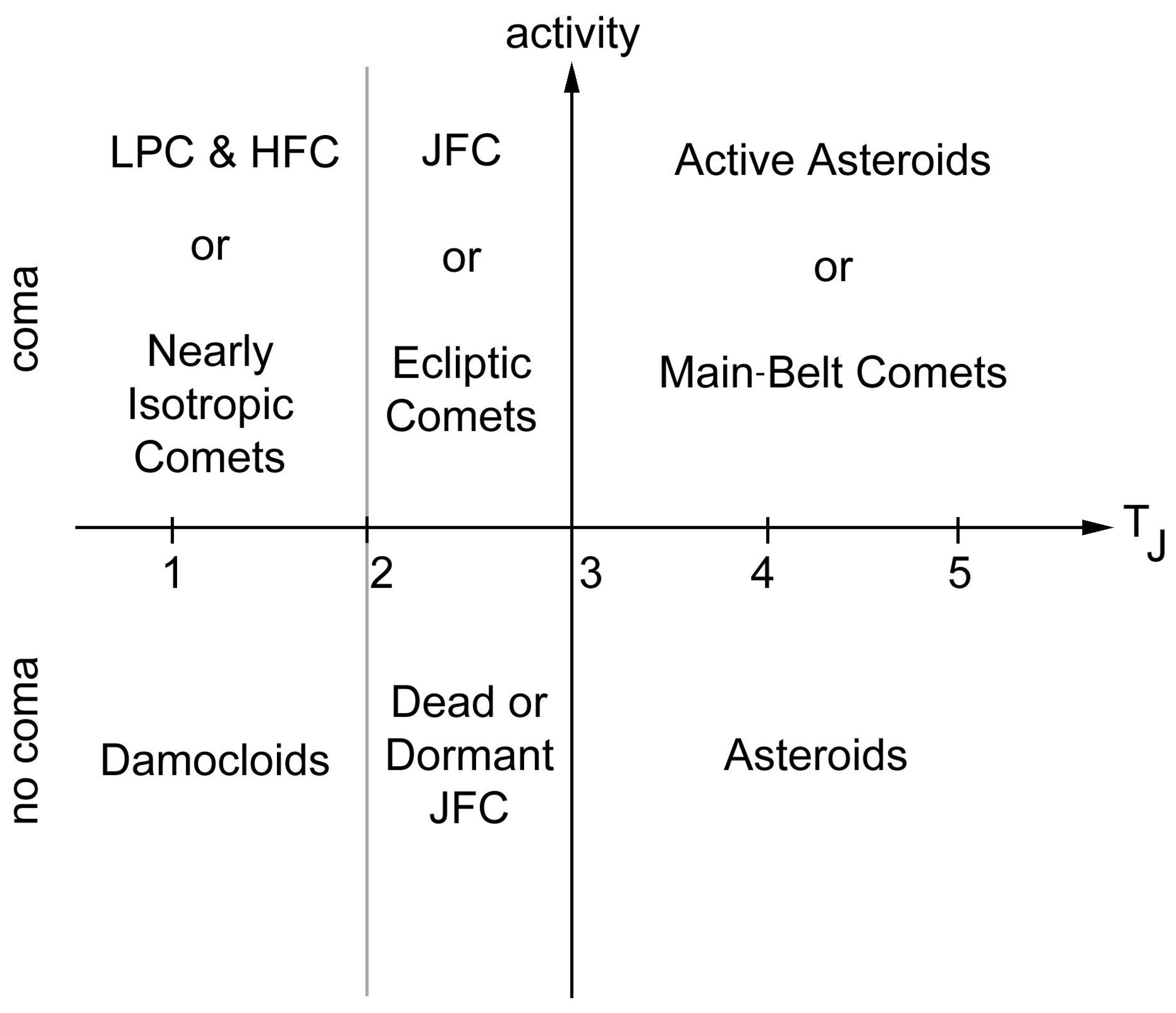
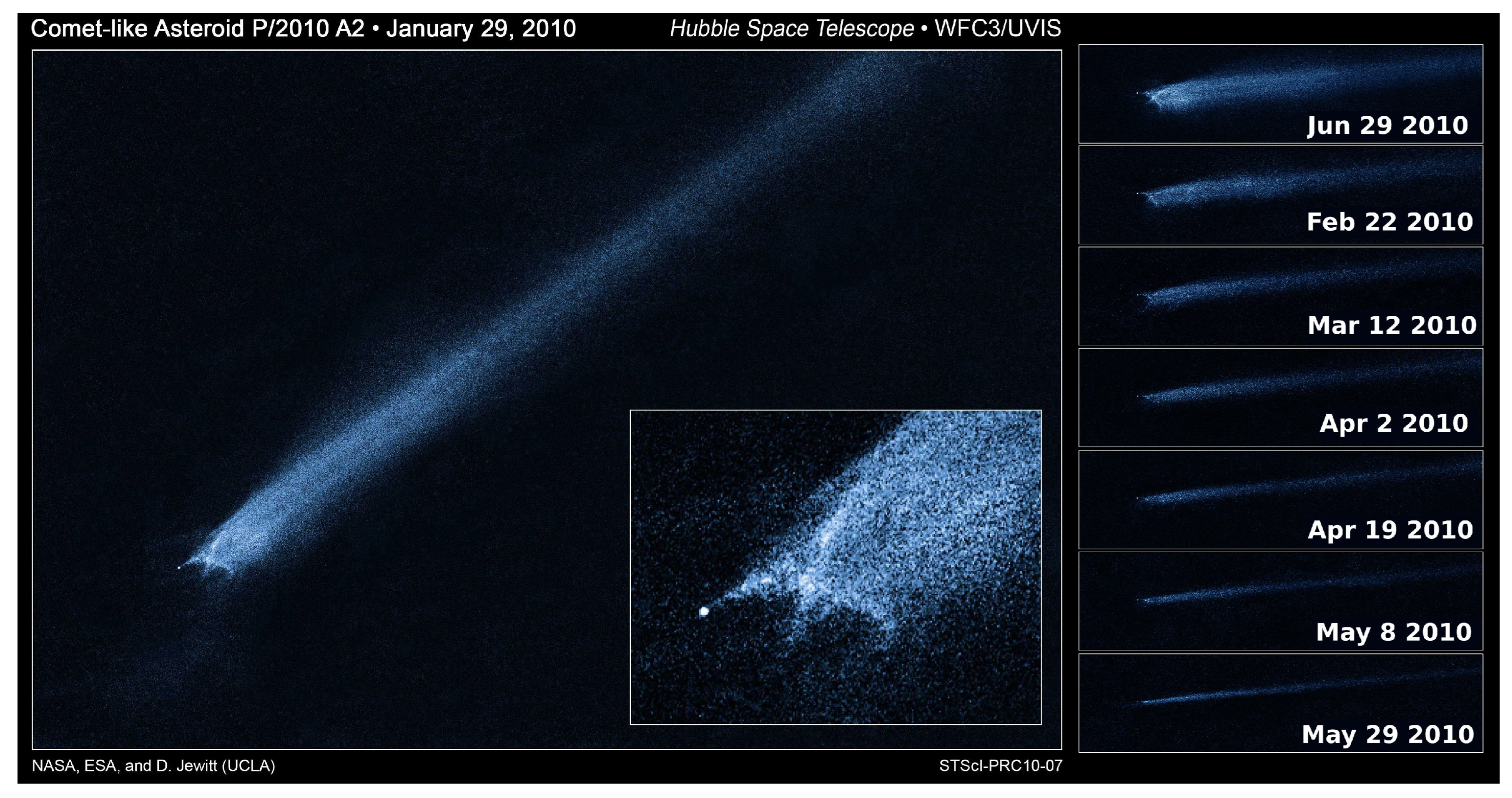
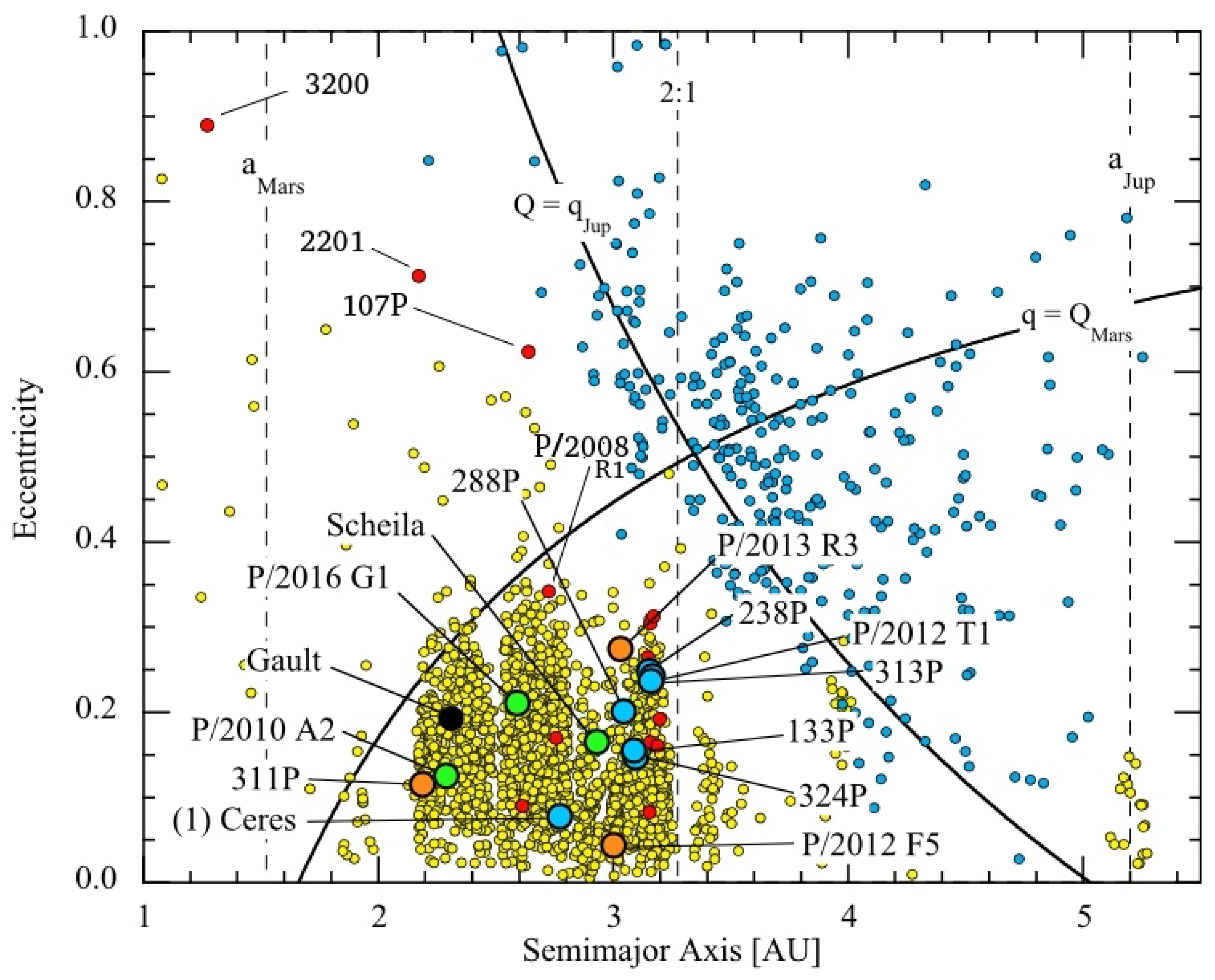
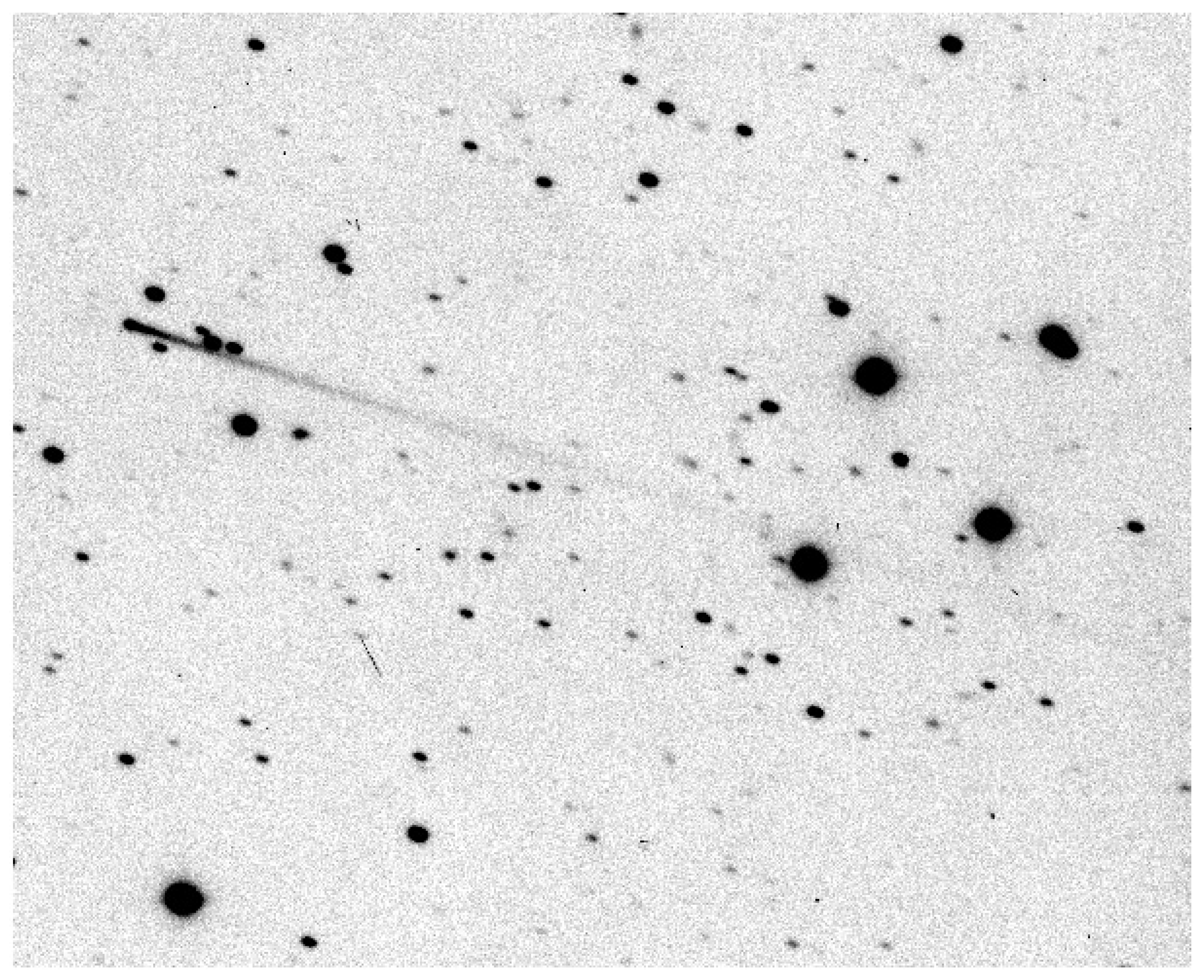
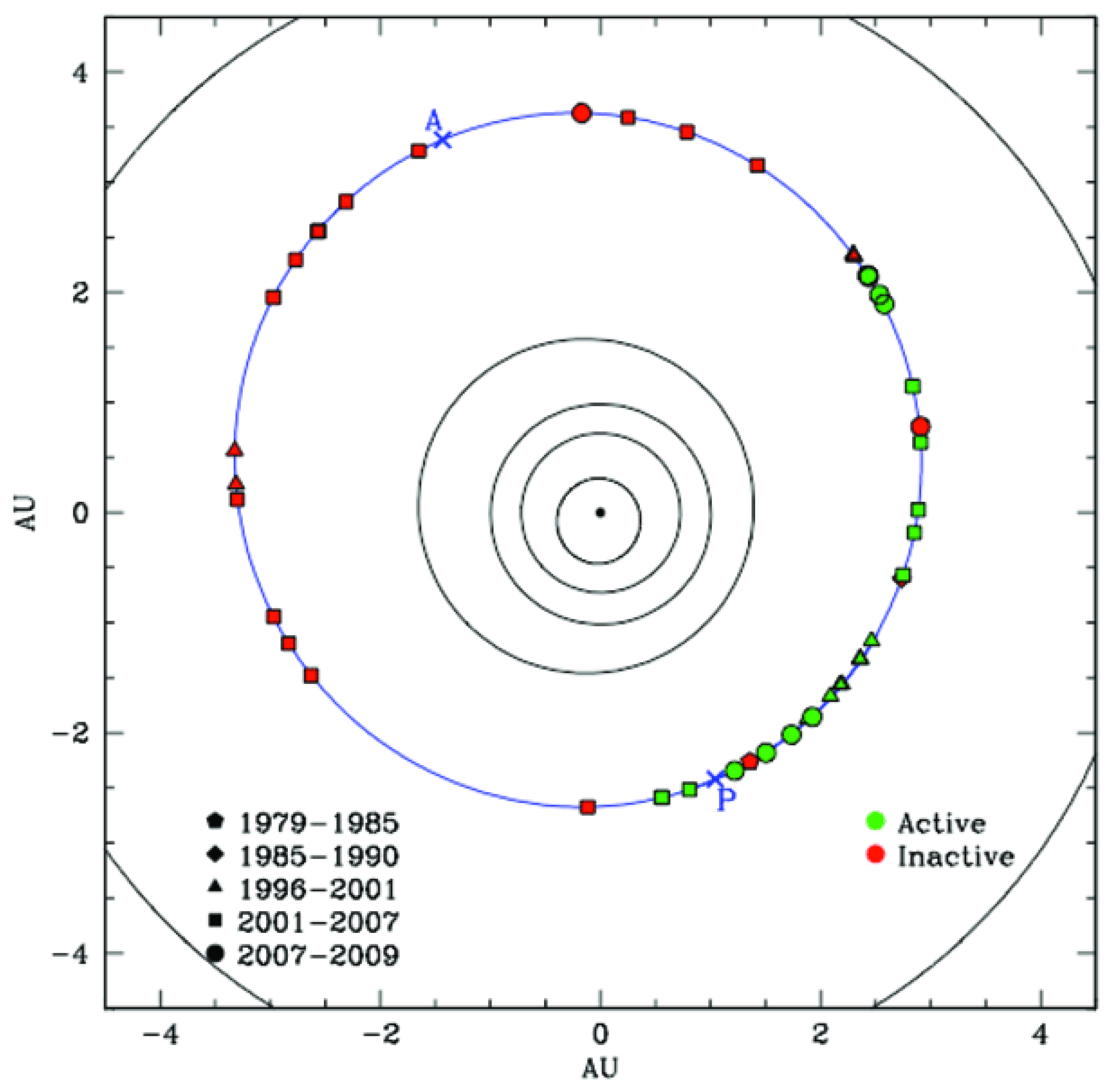
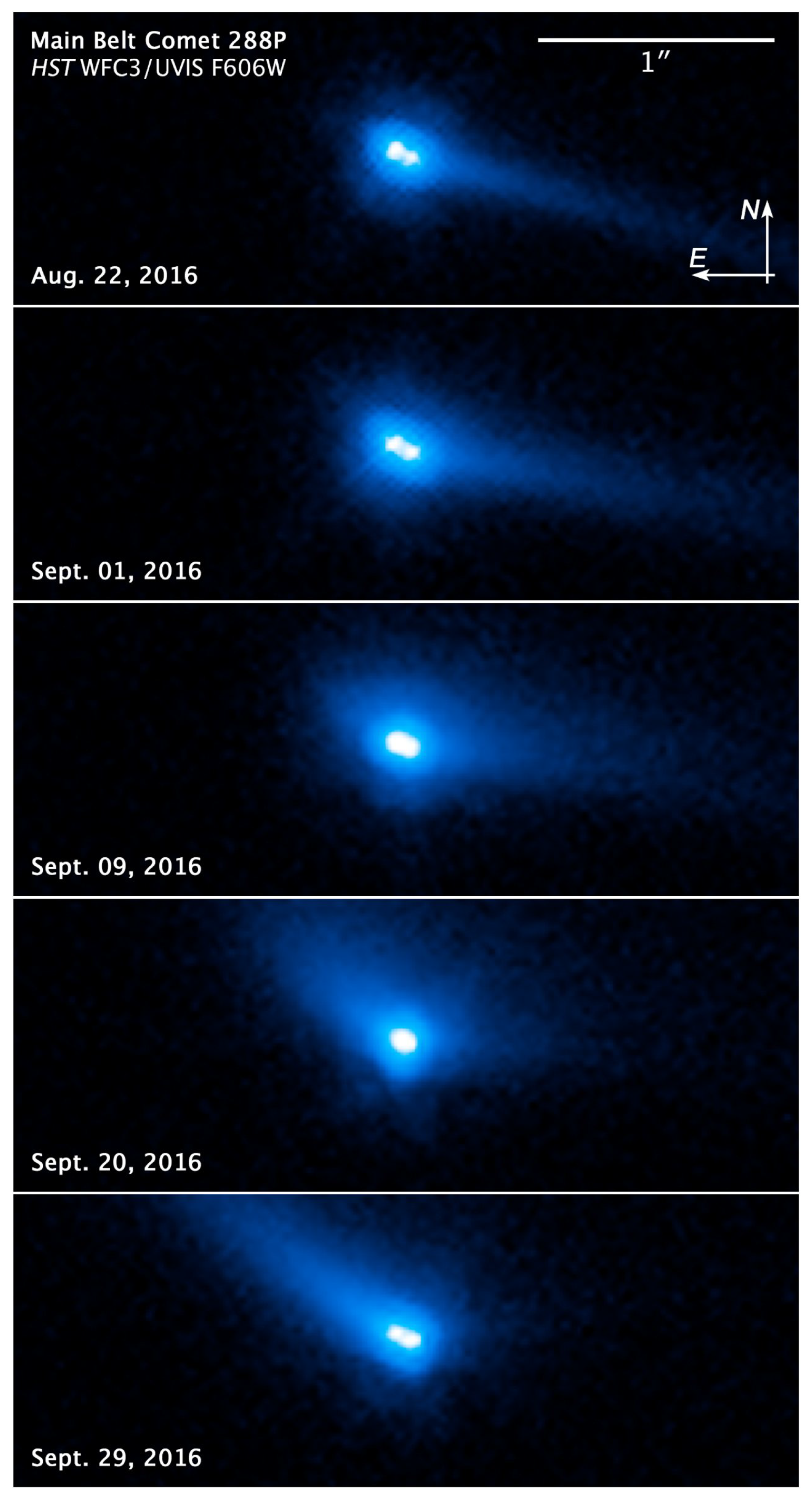
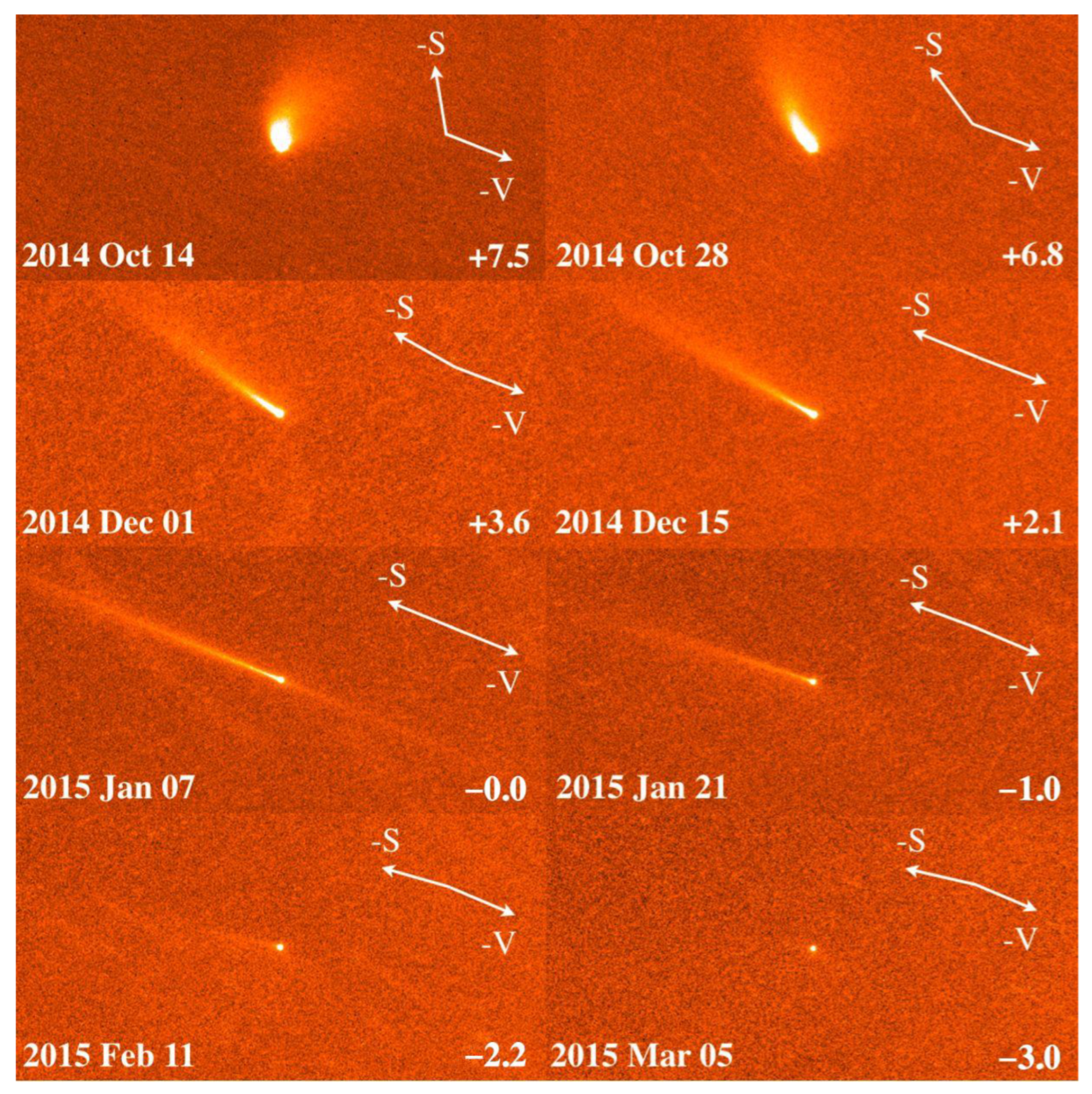
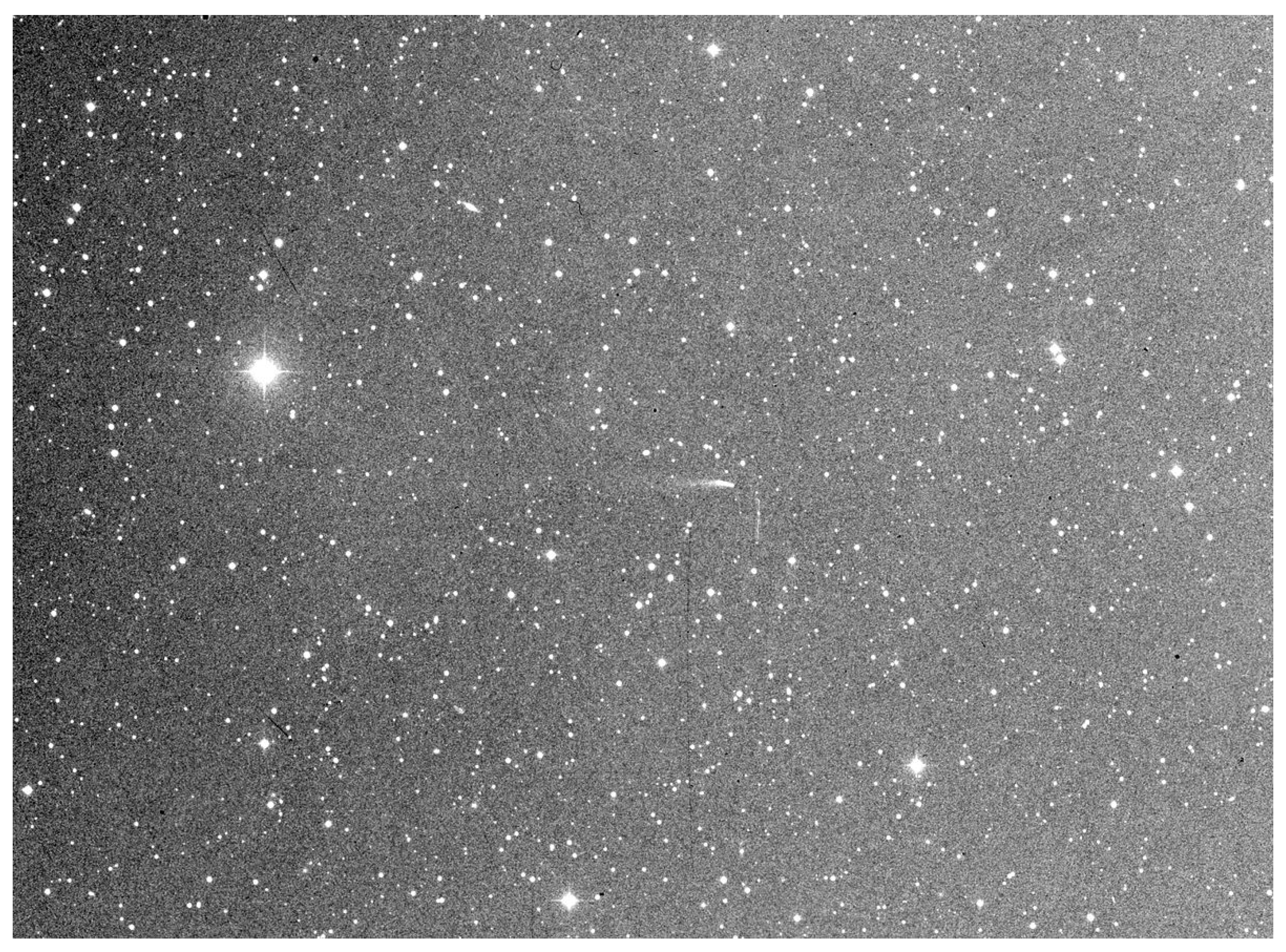
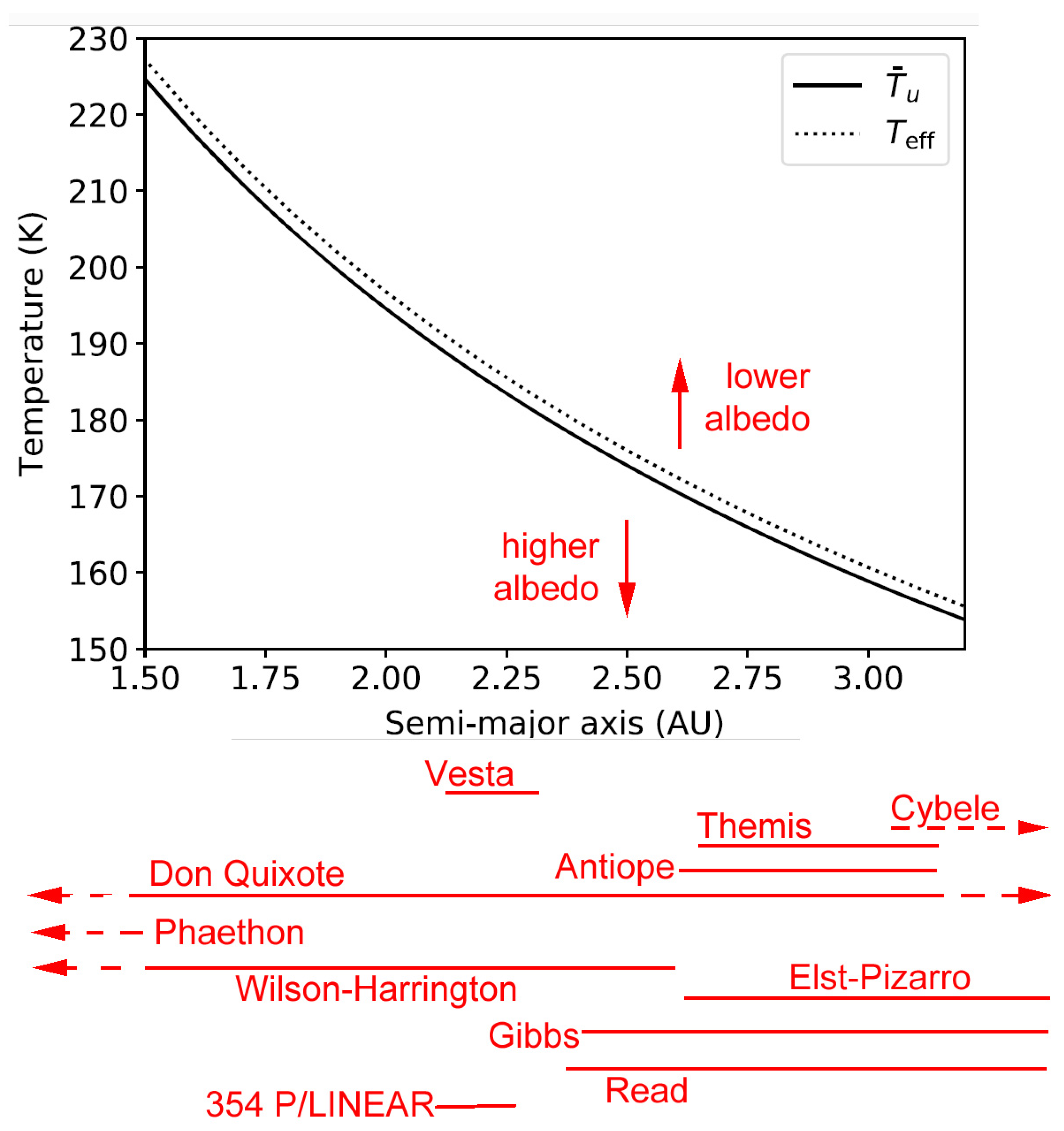
Disclaimer/Publisher’s Note: The statements, opinions and data contained in all publications are solely those of the individual author(s) and contributor(s) and not of MDPI and/or the editor(s). MDPI and/or the editor(s) disclaim responsibility for any injury to people or property resulting from any ideas, methods, instructions or products referred to in the content. |
© 2025 by the authors. Licensee MDPI, Basel, Switzerland. This article is an open access article distributed under the terms and conditions of the Creative Commons Attribution (CC BY) license (https://creativecommons.org/licenses/by/4.0/).
Share and Cite
Kereszturi, Á.; El-Maarry, M.R.; Levasseur-Regourd, A.-C.; Tóth, I.; Pál, B.D.; Kiss, C. Overview of Water-Ice in Asteroids—Targets of a Revolution by LSST and JWST. Universe 2025, 11, 253. https://doi.org/10.3390/universe11080253
Kereszturi Á, El-Maarry MR, Levasseur-Regourd A-C, Tóth I, Pál BD, Kiss C. Overview of Water-Ice in Asteroids—Targets of a Revolution by LSST and JWST. Universe. 2025; 11(8):253. https://doi.org/10.3390/universe11080253
Chicago/Turabian StyleKereszturi, Ákos, Mohamed Ramy El-Maarry, Anny-Chantal Levasseur-Regourd, Imre Tóth, Bernadett D. Pál, and Csaba Kiss. 2025. "Overview of Water-Ice in Asteroids—Targets of a Revolution by LSST and JWST" Universe 11, no. 8: 253. https://doi.org/10.3390/universe11080253
APA StyleKereszturi, Á., El-Maarry, M. R., Levasseur-Regourd, A.-C., Tóth, I., Pál, B. D., & Kiss, C. (2025). Overview of Water-Ice in Asteroids—Targets of a Revolution by LSST and JWST. Universe, 11(8), 253. https://doi.org/10.3390/universe11080253







